INSIDE: FOCUS ON ANTIFOULING
+ BOAT IMPORT TAX EXPLAINED
+ VIKI MOORE’S TOUGHEST VOYAGE
+ A TO Z OF TRAILER YACHTS
+ PICKING YOUR NEXT YOUTH CLASS
+ NEW CRUISING COLUMN
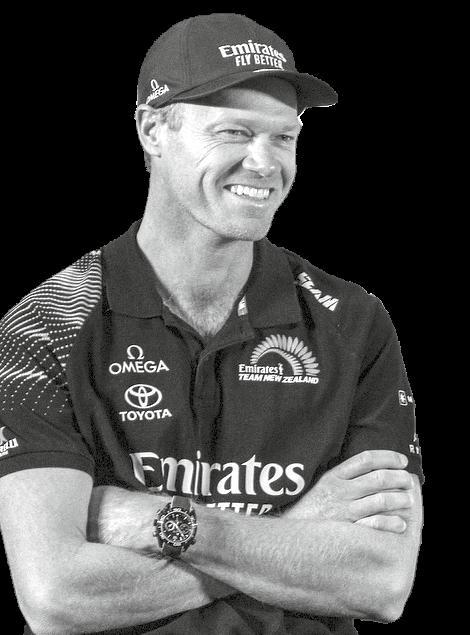
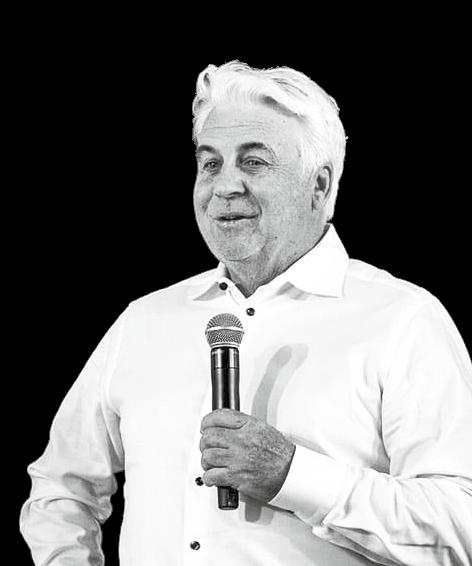
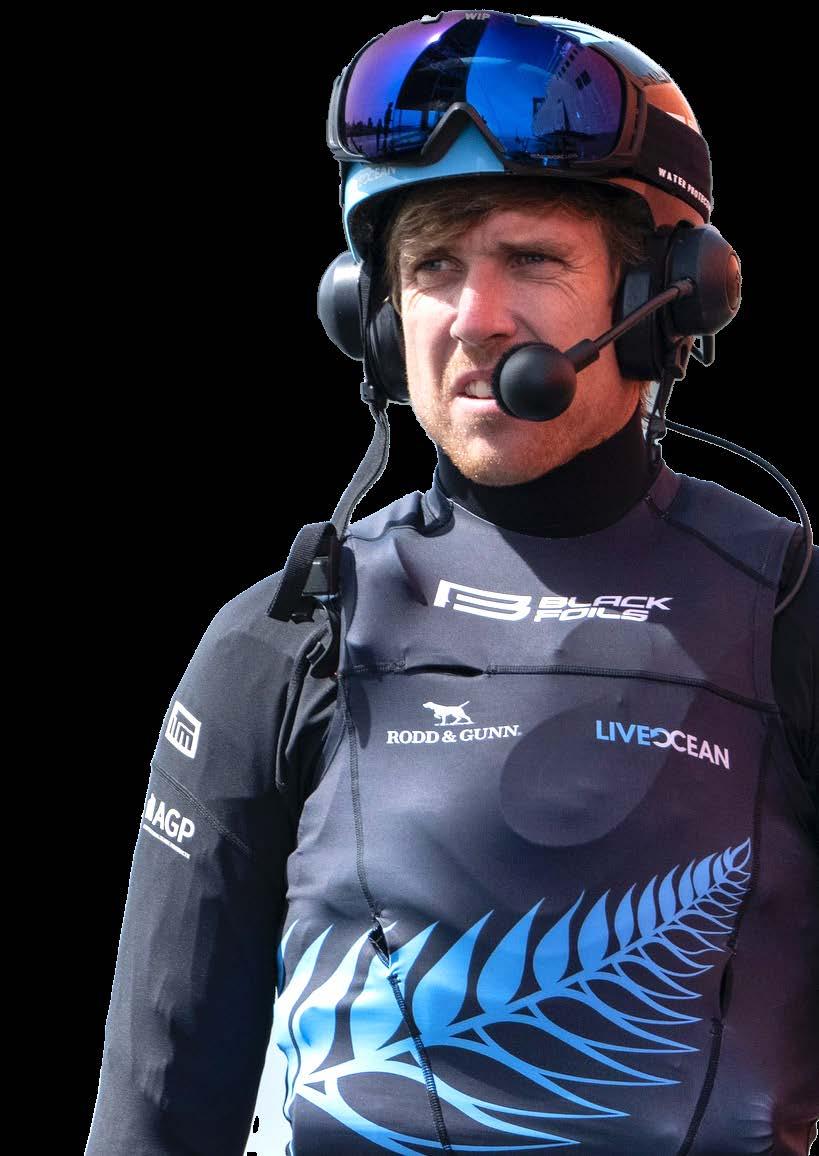
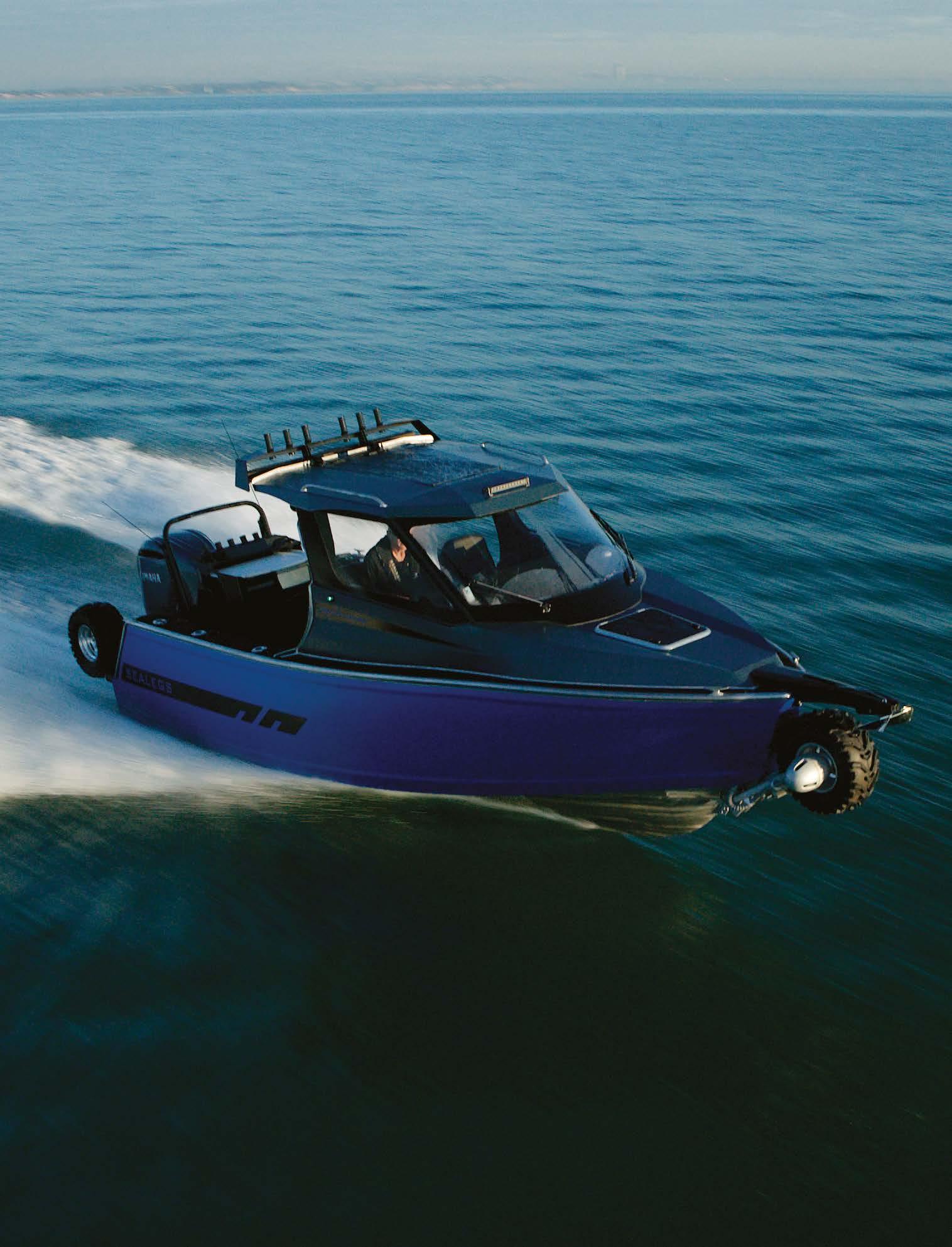




INSIDE: FOCUS ON ANTIFOULING
+ BOAT IMPORT TAX EXPLAINED
+ VIKI MOORE’S TOUGHEST VOYAGE
+ A TO Z OF TRAILER YACHTS
+ PICKING YOUR NEXT YOUTH CLASS
+ NEW CRUISING COLUMN









Lin
Behind
Steve





EDITOR
CONTRIBUTORS
Michael Brown, Wayne Holdt, Suzanne McFadden, Kirsten Moratz, Lin Pardey, Josh Tucker, Kathy Young.
EDITORIAL
Eduan Roos eduan@yachtingnz.org.nz
ADVERTISING
Angela Jordan angela@yachtingnz.org.nz
DESIGN coxandcocreatives@gmail.com
YACHTING NEW ZEALAND 4 Fred Thomas Drive, Takapuna, Auckland 0622
YBQ is published quarterly by Yachting New Zealand.
Cover photo: SailGP
Peter Burling’s bombshell decision to join Luna Rossa for the 2027 America’s Cup sent ripples through the sailing world - and more than a few waves across this country.
For the past three campaigns, Burling has been the heartbeat of Emirates Team New Zealand, leading the sailing team to a historic three-peat across Bermuda, Auckland and Barcelona.
His decision to join an Italian challenger (and one of Emirates Team New Zealand’s fiercest rivals in recent Cups) sparked fierce debate online. While the backlash hasn’t reached the fever pitch Russell Coutts and Brad Butterworth faced when they left Team New Zealand in 2000, there’s an alltoo-familiar undertow to the reaction.
The platforms may have changed, but the sentiment is strikingly similar: the sting of watching a national hero don another burgee still cuts deep.
In this edition of Yachting & Boating Quarterly, we hear from Butterworth himself. Never one to mince words, he offers a staunch defence of Burling’s move, while revealing his own (ultimately unsuccessful) attempt to lure the soughtafter skipper to Swiss outfit Alinghi.
Butterworth also reflects on the future of the Cup and the changes he believes are urgently needed if it is to retain its status as the sport’s ultimate prize.
We also speak with Nathan Outteridge, Burling’s successor at Emirates Team New Zealand, who is fast becoming one of our favourite sailing Aussies.
A dual Olympic medallist and world champion across four different classes for Australia, Outteridge has raced for elite teams around the globe. Now at the helm of one of the sport’s most iconic brands, he
shares insights from inside the camp, talks candidly about stepping into such highprofile shoes, and reflects on the challenge of forging a new chapter with a team woven into New Zealand’s sporting fabric.
This issue also marks a changing of the guard onshore. Steve Armitage has been appointed as the new CEO of Yachting New Zealand, following David Abercrombie’s retirement after 14 years.
Armitage, whose background spans major events, hospitality and tourism, speaks about his background and immediate priorities.
We’re also privileged to share a powerful personal story from Viki Moore, one of our most passionate cruising advocates.
On page 62, she opens up about her cancer diagnosis, the strength she’s drawn from the cruising community, and the importance of staying connected in tough times.
Renowned cruiser and author Lin Pardey launches her new column with a gripping reminder of how quickly conditions can change at sea.
You’ll also find a practical A to Z guide for aspiring trailer yacht cruisers, and a revisit of Peter Bourke’s remarkable solo circumnavigation of New Zealand aboard the yacht he first fell for more than 50 years ago.
Plus, we explore the latest antifouling products and examine what looming tax changes could mean for imported boats.
Thanks for reading and please share your feedback and stories as we aim to keep bringing you the sailing news and insights as it unfolds.
And judging by the dramatic start to the new America’s Cup cycle, we’re in for a thrilling ride.


Top tips on choosing your next youth boat 24

ON THE
Crews’ sights on offshore world champs 32
Olympic heroes back in the boat as strong skiff squad head to Hamilton Island.
Almost exactly a year on from their proudest sailing achievement, New Zealand's "McKiwis" find themselves at another crossroads in their Olympic journey.
Last August, Isaac McHardie and Will McKenzie capped off a remarkable campaign with a silver at the Paris 2024 Games - the country's fourth consecutive Olympic 49er medal, following the success of Peter Burling and Blair Tuke between 2012 and 2021.
Their partnership had begun with a simple exchange of messages and a shared ambition in 2017, and now, eight years on, they're preparing to get back in the boat for the first time since that balmy day on the Mediterranean.
This time, however, the setting is Hamilton Island, and the purpose is different, McHardie says. There's no podium on the line, at least not yet. Rather, their excursion off the Queensland coast is all about recalibration, reconnection and rediscovery.
"I guess you could say it's been the longest debrief we, as a tight team, have undertaken," McHardie said when asked what the pair have been up to since Marseille, where the Olympic sailing was contested. "It's been a busy year, not just reflecting on what we achieved and what worked during the 2024 campaign but

really digging into where we fell short and what we'd do differently.
"In some ways, nothing has changed for us but in other ways a lot has."
McKenzie has moved to Sydney, while McHardie has been finishing his builder's apprenticeship in Auckland and dipping his toes into coaching. There's been


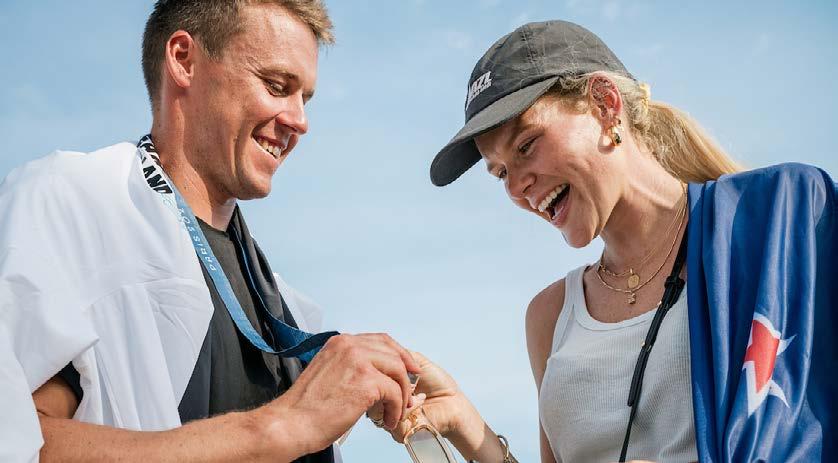
time for life off the water, too. McHardie recently got engaged to his long-time partner Liv Mariano.
"I did it the old-fashioned way," he said. "I took Liv out, got down on one knee, and popped the question."
He's also kept a hand in the big boat scene - TP52s back home, the PIC Coastal Classic, Bay Week - but has taken time

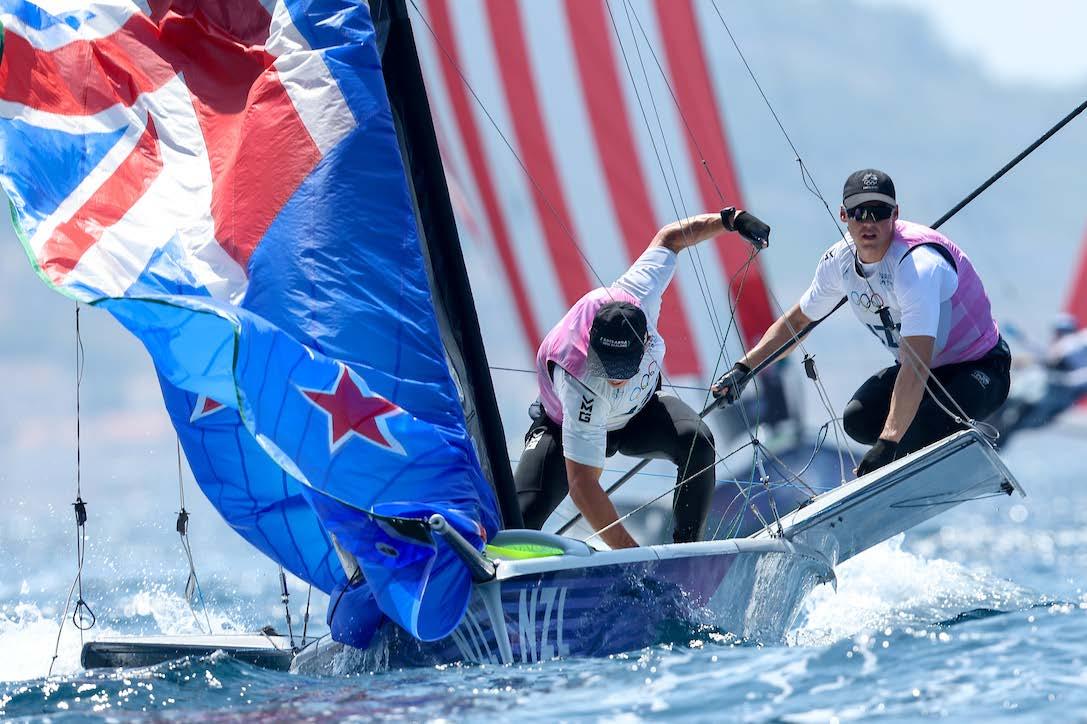
off from the 49er since he and McKenzie finished runners-up to Spain's Diego Botin and Florian Trittel in France.
"It was important for us to refresh after eight years of non-stop campaigning to allow us to come back stronger," McHardie explained. "We also wanted to work on some personal goals while we had an
Continued



opportunity.
"We've spent a lot of time defining what we want from our sailing in this next period and what a new campaign would need to look like. It was a solid campaign last cycle, but Marseille showed us we were lacking some speed in over 15 knots. So, there's plenty to address."
Most recently, he spent time working with the Chinese 49er squad, where - in warm, steady breeze and flat water - his competitive spark was reignited.
"It really lit that fire again and has me excited to get back in the boat," McHardie admitted.
Hamilton Island, then, becomes a critical first step. A squad of New Zealand 49ers and one 49erFX will travel across the Tasman for a training block alongside Australia's top skiff talent in early August. It will be followed by the popular Hamilton Island Race Week, now in its 40th year - a first competitive hit-out for McHardie and McKenzie in 12 months.
Billed as the 'Wetisloe Cup', the event will see the Kiwis and Aussies going headto-head in a series of match races.
"We're really looking forward to stepping

on the boat again," McHardie said.
"It's a brilliant chance to work with the Aussies, to shake off the dust and reconnect with the other Kiwi crews, and to see where we sit against some of the international teams. There's no doubt there'll be some rust and plenty to work on."
McHardie has kept a close watch on the emerging domestic talent, with the fleet blossoming in their absence - Seb Menzies and George Lee Rush won gold at the European championships in Thessaloniki in June, capping off a stellar six-month run that also included a top 10 finish at the Princess Sofia Regatta and victory at Oceanbridge Sail Auckland.
Menzies and Lee Rush have emerged

as the leading pair in a competitive group that includes Sam Bacon and Blake McGlashan, Francesco Kayrouz and Hamish McLaren, and Mattias Coutts with Oscar Gunn - all of whom will sail in the Whitsundays alongside Nicola and Rebecca Hume in the 49erFX.
"It's been cool to see Seb and George do well," McHardie said. "The whole squad have lifted their game and it'll be nice to train with them again at Hamilton Island."
More than just a test of speed or sharpness, the camp will serve as a gauge for what comes next. While McHardie and McKenzie have committed to competing at the 49er world championships in Cagliari this October, they've not yet decided whether to launch a full campaign for the 2028 Games in Los Angeles.
"We're not putting pressure on ourselves to perform at the worlds this year; it's more about getting the answers we need," McHardie said.
"The most important of which is whether we go again. If we do, we know the bar must be higher. We want to win gold this time and dominate the world in the lead-up to the Games."
Rising Kiwi 49er team Seb Menzies and George Lee Rush struck gold at the European championships in Greece in early June - the best result of their careers and the first major success for New Zealand in the class since a silver medal at the Paris 2024 Olympic Games.
Menzies and Lee Rush secured overall victory in a strong men's skiff fleet with a day - and the medal race - to spare, having taken the lead on the second day of competition in Thessaloniki.
They delivered a calm and consistent performance across the week, notching 11 top-10 finishes from 12 fleet races, before also placing fourth in the doublepoints medal race to win the regatta by a commanding 54 points.
American crew Nevin Snow and Ian MacDiarmid were second, with Uruguay's Hernán Umpierre and Fernando Diz third.
New Kiwi pairing Sam Bacon and Blake McGlashan narrowly missed out on the medal race with a 13th-place overall finish - their best result since teaming up last year.
Another emerging duo, Mattias Coutts and Oscar Gunn, placed second in the silver fleet (27th overall), while Francesco Kayrouz and Hamish McLaren finished 49th.
Lee Rush credited their strong position early in the regatta with giving them belief.
"We had a really good second day that put us in the lead, but there was still all of finals racing and the medal race to go, and the points were tight. At that stage, we weren't even sure we'd make the medal race, let alone the podium or a win. But we followed that up with another solid day, and it started to feel possible."
One key improvement, he said, was their starting.
"Our starts have really come along –we've been working hard on it. We've only been competing overseas for the last two years, and it takes time to get comfortable with it [starting] at this level."
Menzies and Lee Rush teamed up in 2021 and found success quickly, finishing third in the 29er at the 2022 youth sailing world championships, followed

by gold in the 49erFX at the junior world championships. But the move to the full 49er hasn't been without its challenges. Gaining the necessary weight to stay competitive in stronger breeze has been the biggest hurdle, Lee Rush admits.
"It's been our top priority for a few years now. We're getting there, but it's a longterm thing. It takes time to adjust to the 49er - the racing, the starting, just doing regattas and building experience."
They've been steadily climbing the ranks over the past year. They finished fourth at last year's junior world championships, just days before Isaac McHardie and Will McKenzie took 49er silver at the Paris Games.
In the Olympic medallists' absence, Menzies and Lee Rush won the 2025 Oceanbridge Sail Auckland in February, placed ninth at the Princess Sofia Trophy in Palma in April, and came 13th at French Olympic Week in Hyères a fortnight later. Their progress owes a lot to the depth and quality of the New Zealand 49er squad, which includes Bacon and McGlashan, Coutts and Gunn, and Kayrouz and McLaren.
"We had a really solid training block back home in the New Zealand summer. There are consistently five high-level boats pushing each other, all working towards the same goal. Not many countries have that kind of depth and being part of a squad like this makes a huge difference," Lee Rush said.

"We're all close. We train together, travel together, and stay together overseas. That bond helps, especially when we're pushing each other at such a high level, and it's a big part of why we’ve got to this point."
Winning the European championships is unquestionably a career highlight.
"Seb's had a lot of success in the 420, but for me, this is definitely number one, and I think he'd put it pretty high up there, too.
"It's a senior class. It's not a world championship, but it's still a massive win, and we didn't expect to be winning an event like this so soon in our 49er campaign."
The pair have their sights set on the Los Angeles 2028 Olympics but know there's a long road ahead.
"It's a great result; to be able to show that we can perform against other toplevel boats and that we can put together a regatta across a full week and keep ourselves consistent and calm under pressure. But it's still just one regatta, and we have a lot to prove," Lee Rush said.
"More importantly, it's special for the whole squad. We're all working towards the same goal - trying to get one of us to go to the Olympics and perform in 2028. This is definitely a win for the squad as much as it is for us."
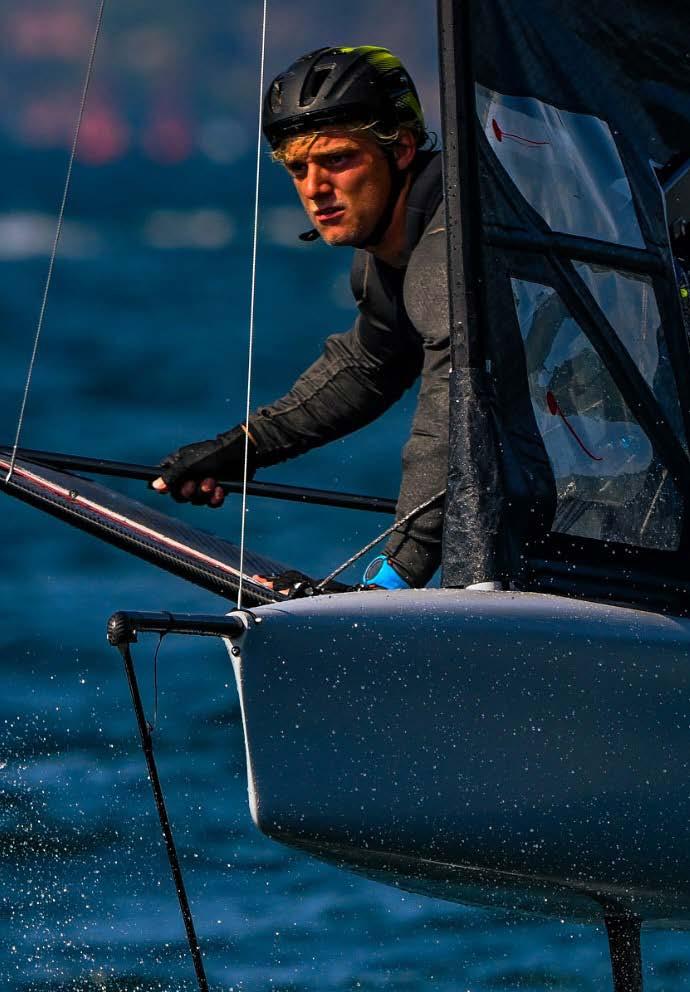
Jake Pye (above) stormed to third overall at the 2025 Moth world championships on Lake Garda in July - and finished as the top youth sailor in the fleet - courtesy of three top-three finishes from six gold fleet races. Defending world champ and NZ teammate Mattias Coutts was 12th. Photo / Martina Orsini

George Gautrey (above) narrowly missed the podium at the Long Beach Olympic Classes Regatta, finishing fourth in the ILCA 7 with a race win and four other top-three results. Caleb Armit was 18th, while Greta Pilkington climbed to 16th in the ILCA 6 after winning the final race Photo / World Sailing
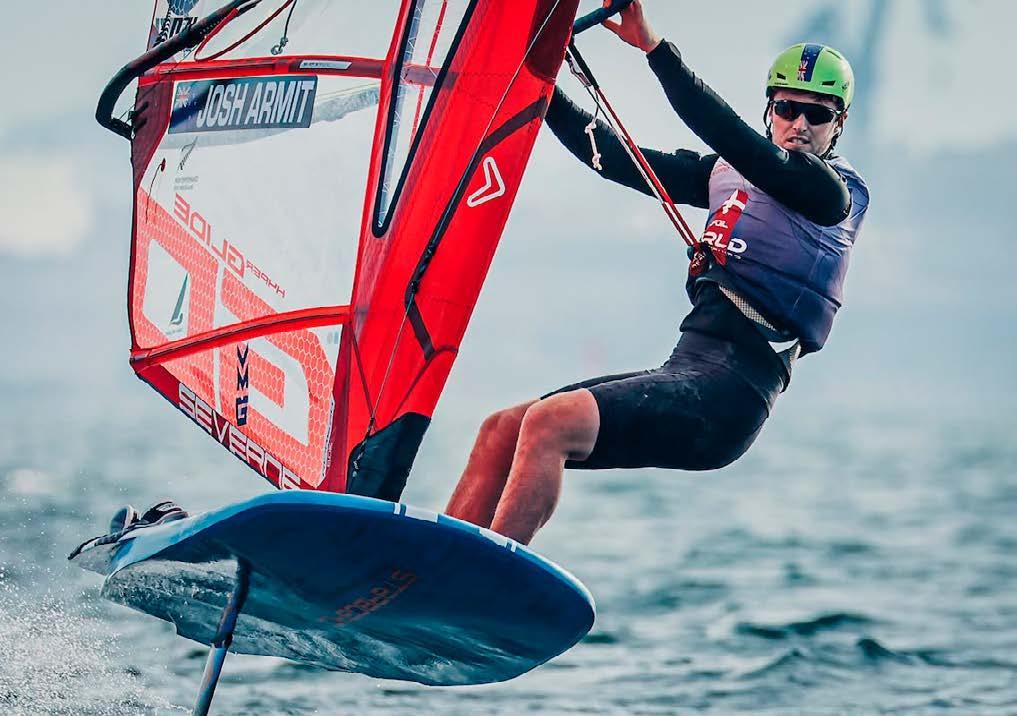

Over the past two months, New Zealand sailors have delivered impressive performances at premier international regattas, showcasing their skill and determination on the global circuit.
The Kiwi IQFOiL squad faced a frustrating finish at the world championships in Aarhus, Denmark, as light winds on the final day prevented racing and a shot at the new top-8 medal series. Veerle ten Have placed 10th overall, Josh Armit (top) 15th, Aimee Bright (above) impressed with 15th and a top-5 under-23 finish, Stella Bilger was 23rd, and Eli Liefting 74th. Photos / Sailing Energy

All eight Kiwi teams made the gold fleet at the 29er Euro Cup during Kiel Week. Will Leech and Will Mason (above) led the charge with silver, Nelsen Meacham and Joe Leith claimed seventh, and Bella Jenkins and Jess Handley were the top girls’ team in 20th. Photo / International 29er Class
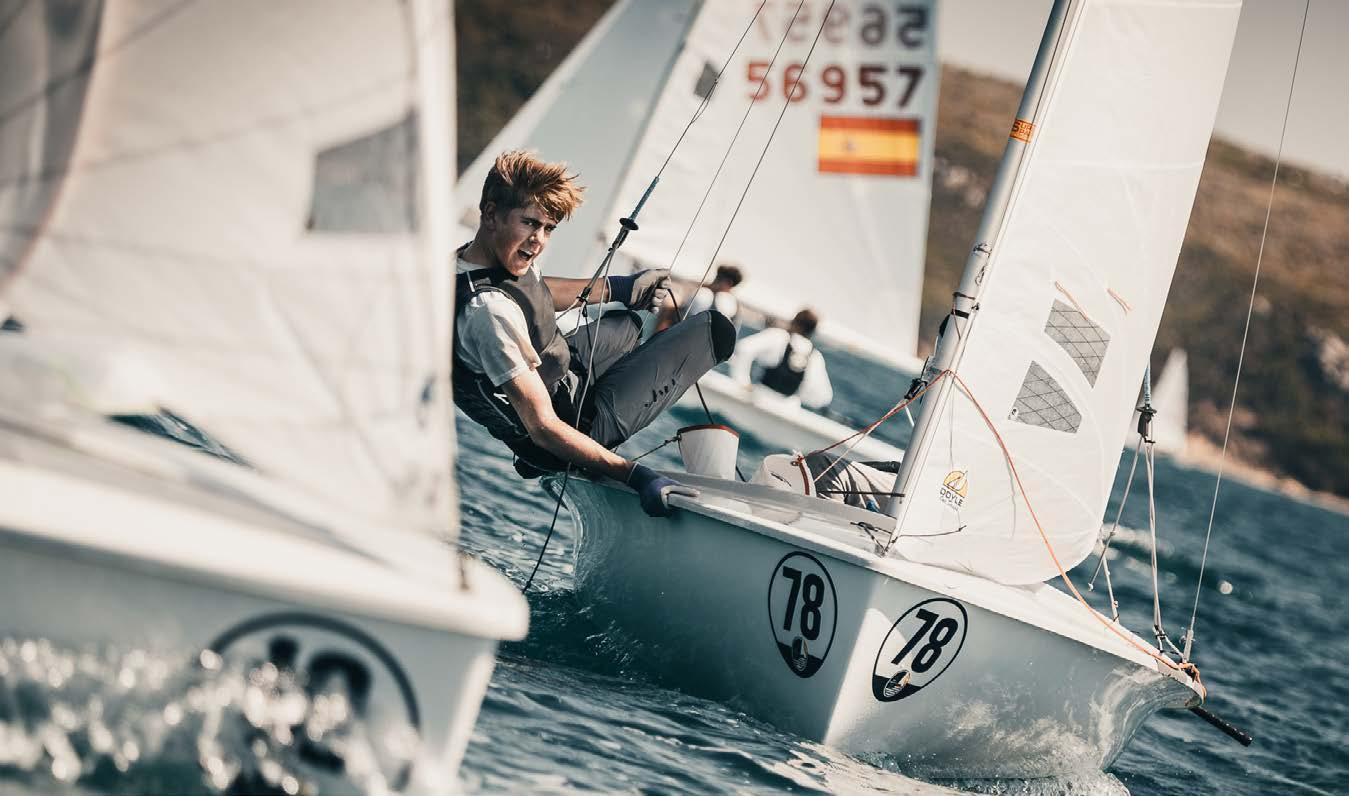
NZ duo make gold fleet in Urla
The 420 world championships in Urla, Turkey, concluded with both Kiwi crews making the gold fleet. Cam Brown and Oli Stone (above) finished 16th overall with five top-10 placings, while Ashton and Simon Cooke placed 33rd in a competitive 101-boat fleet.
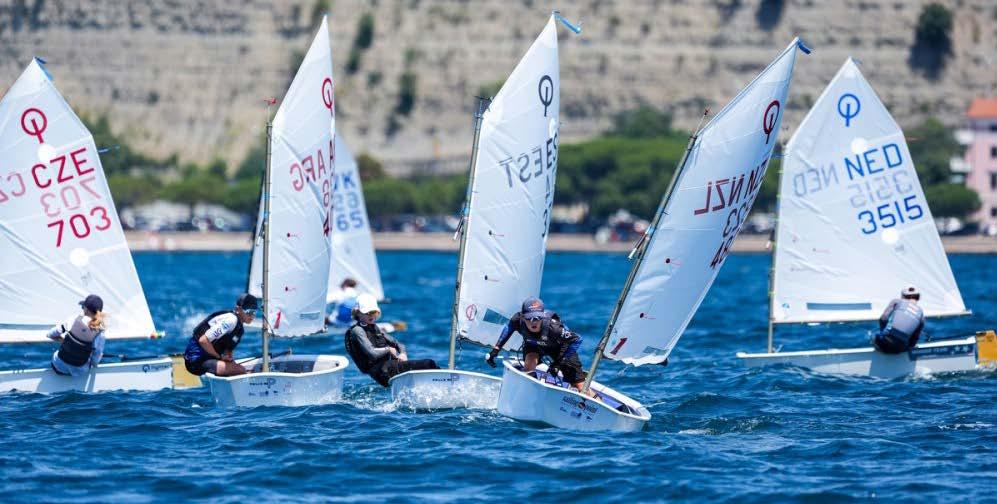
Top 10 for young Opti star
Matteo Barker (above) was 10th overall at the 2025 Optimist world championships in Portorož, Slovenia, with four top-10 qualifying results during the first week of July. The Murrays Bay Sailing Club sailor was followed by Jake Dickey (29th), while Blake Duncan, Will Fyfe, and Nathan Soper competed in the silver and emerald fleets. Photo / AlesFevzer


At the 29er European championships at Lake Garda, Italy, Kiwi crews delivered strong results in a 251-boat fleet. Ewan Brazle and Toby Clark (top) won the under-17 title and finished 21st overall. Nelsen Meacham and Joe Leith (above) placed 11th, narrowly missing the top 10 on countback but were the top non-European team. Will Leech and Will Mason finished 14th overall, while Bella Jenkins and Jess Handley were the top female team, placing 101st overall and 14th in the bronze fleet. Photos / International 29er Class


Kiwi Racing (above) finished second at the 2025 team racing world championship in Newport, Rhode Island, held from May 28 to July 1. Despite limited international experience, the young team - led by Reuben Corbett and including Jordan Stevenson, George Angus, Maeve White, Mason Mulcahy, Luis Schneider, Oliver Lloyd, and Zoe Dawson - surged through the fleet and edged out rivals on a tie-break after five intense days on Narragansett Bay. Photo / Paul Todd, Outside Images
Sean Herbert (left) claimed the 2025 US wingfoil championships title in June, just days after also earning bronze at his debut Wingfoil Racing World Cup event in Switzerland. The 23-year-old Kiwi, who began sailing in an O’pen Skiff in Auckland, is now turning heads on the global stage with consistent performances against the sport’s best. Photo / IWSA Media, Robert Hajduk

Lukas Walton-Keim (above) finished strong at the Formula Kite European championships in Urla, Turkey, securing second place in the final day’s second race and 14th overall - just 15 points shy of the top-eight medal series. Lochy Naismith ended his regatta 15th in the silver fleet.
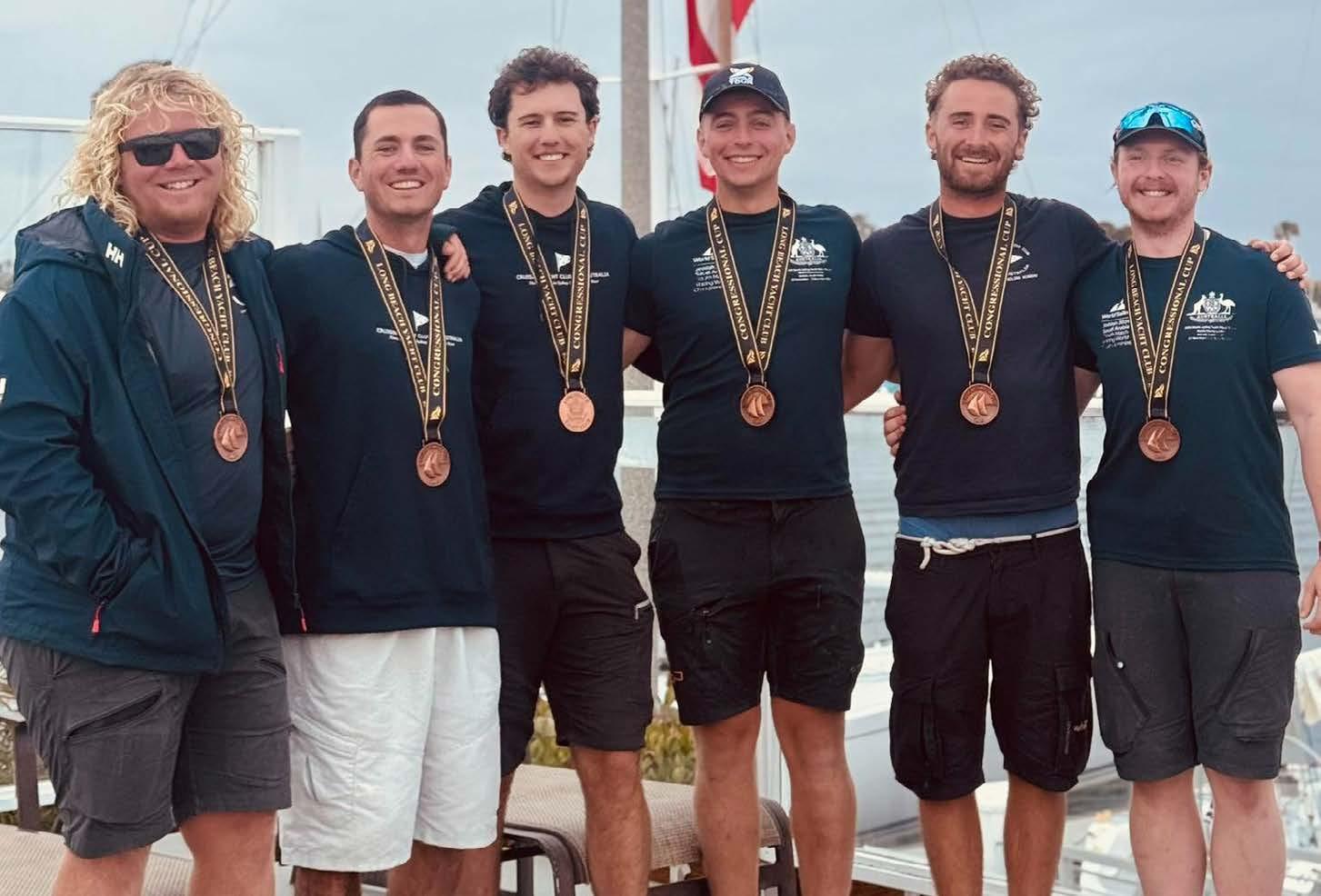

Veerle ten Have (above) kicked off her new Olympic campaign with a bronze medal in the women’s iQFOiL at the Princess Sofia Trophy in Palma. The 24-year-old Tauranga sailor showed speed and consistency, winning eight qualifying races and advancing to the final, where she finished third behind Britain’s Emma Wilson and China’s Zheng Yan. The podium marks her first major result since placing 10th at her Olympic debut in Marseille last August.
Cup success for NZ match race ace
Jack Frewin (third from left) placed third at the 2024 Congressional Cup in Long Beach, one of the world’s most prestigious match racing regattas. He sailed as tactician for Cole Tapper’s team from the Cruising Yacht Club of Australia. Photo / RNZYS

Tom Saunders (above) marked his return to international sailing with a silver medal at the French Olympic Week in Hyères, his first major regatta since the Paris 2024 Olympics. He secured second overall in the ILCA 7, delivering a strong medal race performance to climb ahead of top competitors. Saunders was one of two Kiwis fighting for podium spots, with Josh Armit finishing fifth overall in men’s iQFOiL. A few weeks later at the 2025 ILCA world championships in Qingdao, China, Saunders finished 22nd with light breeze severely limiting raceing. Photo / Sailing Energy

America’s Cup legend hits back as Peter Burling’s Italy move stirs old emotions and new questions.
One of New Zealand’s most revered sailors has come out in support of another, with Brad Butterworth publicly defending Peter Burling’s shock decision to join America’s Cup rivals Luna Rossa.
Burling, the three-time America’s Cup-winning skipper, confirmed in May that he would not return to Emirates Team New Zealand for the 38th edition of the event. Instead, he has joined the Italian syndicate’s leadership and development team, bringing with him a wealth of experience and tactical nous.
The announcement sparked a wave of admiration, disbelief - and even angerwithin the sailing community.
Countless online comments in the immediate aftermath lamented Burling’s move as a betrayal, while others warned it could have major implications for the next America’s Cup, set to be raced in Naples in 2027.
But if anyone understands what Burling is going through, it’s Butterworth.
The four-time Cup winner was cast as a villain when he and Russell Coutts left Team New Zealand for the Swiss syndicate Alinghi in 2000.
Long regarded as one of New Zealand’s most accomplished sailors and a Hall of Fame inductee, Butterworth’s career has included multiple world championship triumphs, as well as victories in the then Whitbread Round the World Race, the Sydney-Hobart Race,
and the Admiral’s Cup.
He became part of sailing folklore aboard Steinlager II, which swept every leg of the 1989-90 Whitbread - a feat no other boat has achieved. Butterworth rose to prominence in the America’s Cup as Team New Zealand’s tactician, playing a key role in landmark victories in 1995 and 2000 under skipper Coutts.
The decision to jump ship to Alinghi, backed by billionaire Ernesto Bertarelli, was driven by internal rifts within Team New Zealand and unleashed a wave of public fury back home.
This included the now-infamous ‘BlackHeart’ campaign, which branded Butterworth and Coutts “traitors” and escalated to the point where both men’s families received threats, prompting police involvement.
Butterworth went on to help his adopted team to a 5-0 demolition of Team New Zealand in the 2003 America’s Cup, making Alinghi the first European outfit to lift the Auld Mug and cementing one of the most bitter chapters in New Zealand’s sporting history.
Now, more than two decades later, he is calling for perspective.
Speaking to YBQ shortly before departing on the Transpacific Yacht Race - a biennial offshore event spanning 2,225 nautical miles from Los Angeles to Hawaii - Butterworth said he saw echoes of his own saga in Burling’s recent move.


‘It’s a lot more tempered now! Back then, we had to put up with death threats, threats on our family - all sorts of s***. It was as bad as you could make it.’
Brad Butterworth
“They used that word very liberally back when we left Team New Zealand,” Butterworth said of those now labelling Burling a traitor. “It’s a lot more tempered now! Back then, we had to put up with death threats, threats on our family - all sorts of s***. It was as bad as you could make it.”
Butterworth, who has maintained close ties with Alinghi and is a current board member, said Burling’s departure from Team New Zealand came as no surprise.
“Everybody [in America’s Cup circles] Continued on p18

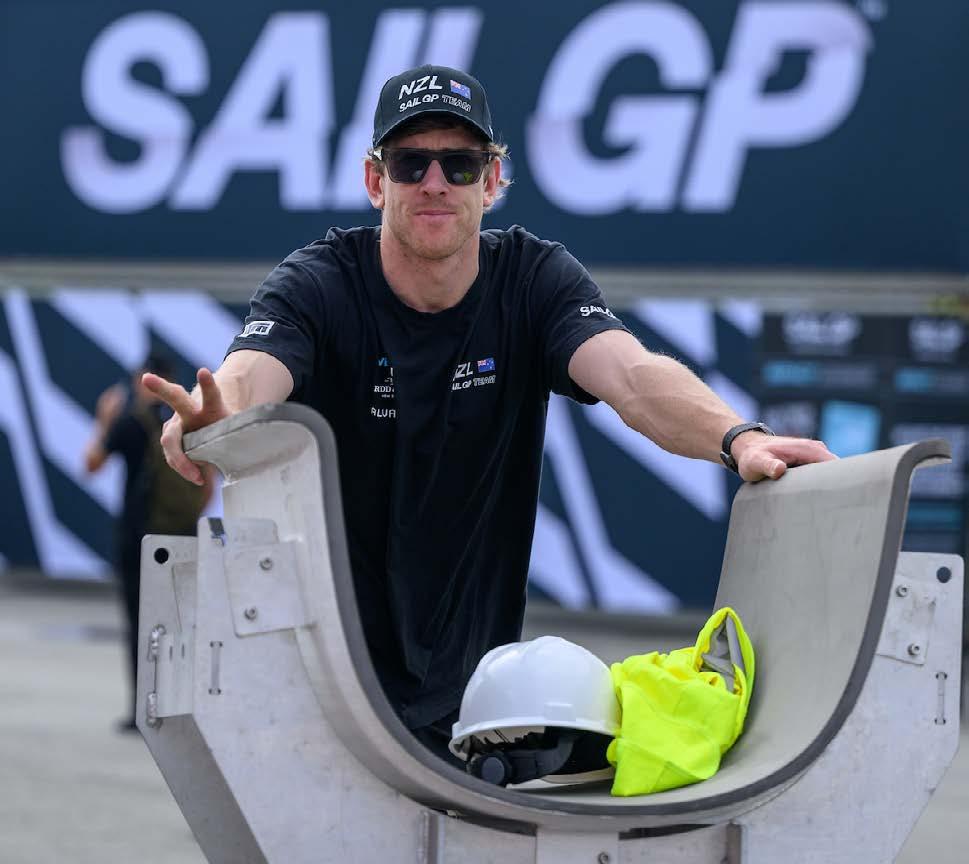









Continued from p21 candidate,” Team New Zealand boss Grant Dalton said. “I mean, he’s won Olympic gold and silver medals and is a multiple world champion.
“He did a fantastic job in Barcelona, integrating easily into the team, and he’s a great communicator. He was always destined to be skipper after Pete departed.”
Outteridge was also heavily involved in discussions around the makeup of the sailing team for the next campaign.
Retaining Blair Tuke and Andy Maloney were priorities, and they’ve also promoted former Olympic bronze medallist Sam Meech, who was part of the wider sailing team in Barcelona.
The only newcomer so far is Great Britain’s Chris Draper, someone Outteridge knows well, and who has


a similar CV with extensive 49er, America’s Cup and SailGP experience.
“Obviously with Pete’s departure, there was some big shoes to fill there,” Outteridge said, “so we’ve been thinking long and hard about how to add new dynamics to the team.
“You can never replace someone like for like, so you’re out looking for other opportunities. We’ve got an amazing sailor in Chris Draper.
“I raced with him in SailGP when I was driving the Japanese team. It’s always important when you’re putting together a team that you work with people you understand, you know and you respect.
“I think he’s going to slide in nicely. The next job now is to work out how to keep building depth within the team and


‘Obviously with Pete’s departure, there was some big shoes to fill there, so we’ve been thinking long and hard about how to add new dynamics to the team. You can never replace someone like for like, so you’re out looking for other opportunities.’
Nathan Outteridge
we’ll be looking at the next generation of New Zealand sailors because, ultimately, we’re all getting older and someone needs to replace us eventually.”
For now, though, it’s Outteridge’s time.
Like Burling, he brings an analytical brain to the role and is renowned for working with design teams to find that extra click of speed.
Even in his early days in the America’s Cup, he spent countless hours discussing theories with the likes of Iain Percy during their time together with Swedish outfit Artemis.
It was the very early days of foiling and the gains to be made were significant.
Now the small margins make all the
difference.
But for all of Outteridge’s meticulousness, he can also be superstitious. During his Olympic sailing days, he would never shave or cut his hair during regattas - he reasoned it was acceptable during longer events like the America’s Cup - and will never wear event clothing while it’s taking place.
It’s an approach that’s clearly worked for him so far, even if he’s a long way away from the world of 18-foot skiff sailing.
Michael Brown is a sports producer for TVNZ and former Yachting New Zealand communications manager.


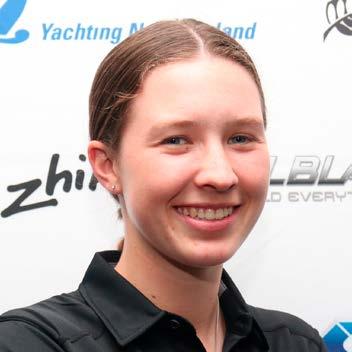

Pilkington also values the history and lessons the class offers.
"There's just so much history in the ILCA, a lot of incredible sailors who've gone on to be really successful, whether that's in the Olympics, America's Cup or other professional sailing, have come through this class," she said.
"It teaches you a lot of important lessons, and I think that's helped shape me as a sailor."
Top tip: "Take your time and try different classes. Everyone's different, so it's about figuring out what suits you best.
"And above all, keep enjoying your sailing. Learn to say 'yes' to new
opportunities. You often learn the most where you least expect to."

European champion (49er)
Menzies sailed multiple classes throughout his youth sailing career. He started in the Optimist and also competed in the P Class. At 13, he moved into youth classes, focusing mainly on the 420 for much of his early development.
"The 420 appealed to me because it's

a technical boat that requires a high level of accuracy in setup, especially when it comes to tuning the mast and sails together through prebend and rig tension," Menzies said. "I knew that long-term I wanted to sail a skiff, but going through the 420 gave me the chance to learn as much as I could early on."
After Covid-19, Menzies spent a season in the 29er before moving to the 49er the following year: "I knew I would eventually sail the 49er, but I wasn't quite heavy enough yet. I also wanted to gain experience crewing and being on the wire. That's when George [Lee Rush] and I teamed up to do a season in the 29er."


Menzies has always aimed to be proactive when changing classes.
"Ever since the Optimist days, my dad and I had talked about eventually moving into the 49er, and we planned out which classes would give me the best preparation along the way."
Top tip: “Pick a class that helps set you up for the sailing you want to do in the future. Also, choose a boat you enjoy, and sail with people you like. It makes the whole experience more fun."
Paris 2024 Olympian (iQFOiL)
Armit was a standout from a young age.
At 13, he became the youngest ever Starling nationals winner, and two years later received the Sir Peter Blake Memorial Trophy, joining the ranks of Peter Burling and Jo Aleh. He progressed to the ILCA class, winning the under-17 world championships in 2017 and the ILCA 6 youth world title in 2018, confirming his status as a talented sailor.

A tough transition to the ILCA 7 at just 17, combined with Covid-19, forced a rethink.
"It was a good time over Covid to just rethink what I was enjoying and plan how to go about things," Armit said last year.
"I had a lot of mates doing windfoiling and telling me how sick it was and to get into it. I gave it a go and got pretty addicted."
"I started racing in the Optimist but quite quickly moved into Starling and then the ILCA 6," Armit said. "I found myself quite quickly outgrowing the junior and youth classes and having to move on because of this."
The speed and adrenaline of foiling appealed, while his experience in other classes helped him transition smoothly.
Top tip: "Find a class you enjoy sailing and are having a lot of fun racing and training."
Continued on p28
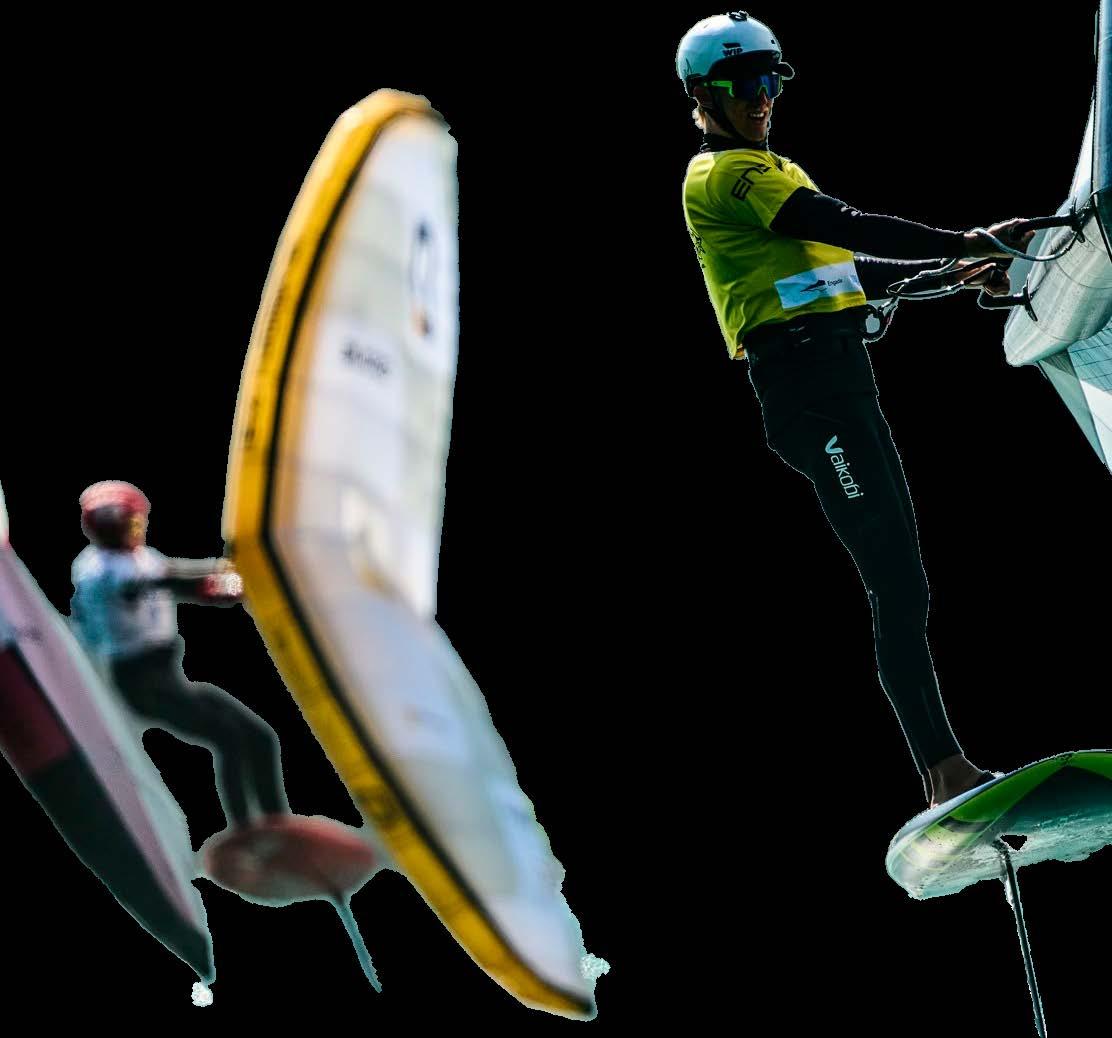

World Cup medallist (wingfoil) Herbert's sailing journey began at age 9, inspired by O'pen Skiffs at Manly Sailing Club.
Though initially uninterested, his brother's enthusiasm sparked a rivalry that pushed Herbert to compete in fast boats.
He started in the O'pen Bic (now O'pen Skiff) because, as he says, “Learning should be enjoyable - not about bailing water out of your boat in the middle of winter!" The O'pen Skiff was an emerging
class then, and by 2017 it had become a well-established pathway for young sailors.
Herbert's progression also included the Optimist, Starling, 420 for schools team racing, Waszp, 29er, Moth, and now wingfoiling.

"The Waszp was a natural next step after the Starling," he said. "It's the first performance foiling class, and at my size it was perfect to start foiling in one-
design racing. There's plenty of adjustments you can make to suit your preferences, which helps young sailors learn."

When choosing youth classes, Herbert looked for competitive racing and enjoyed switching classes to keep things fresh.
He settled on wingfoiling because it's exciting.
"I get to go fast foiling, setup times are
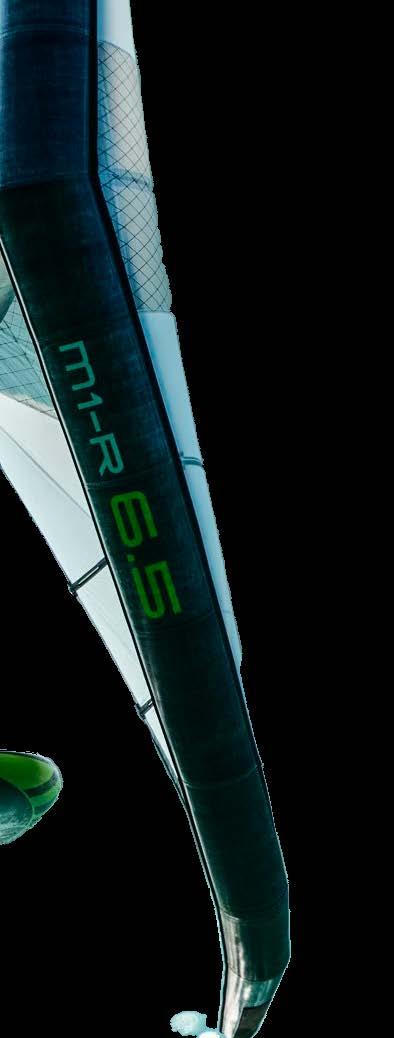
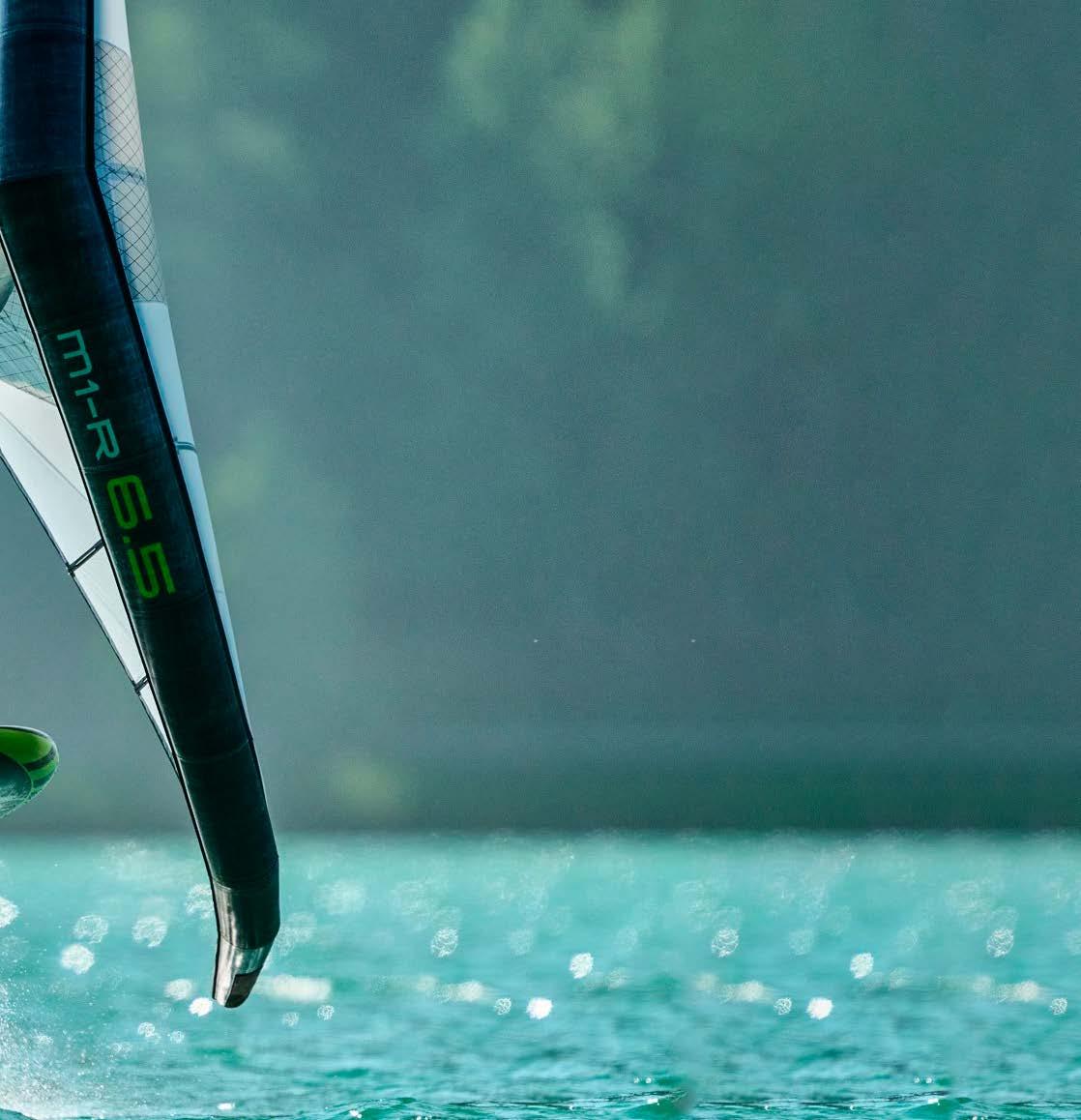
short, and I can maximise my time on the water. I'm fortunate to be involved in developing the equipment, which challenges me mentally and physically as I adapt. Best of all, I get to do it with my mates!"
Top tip: "Try new things, ask mates or club members to help you try different boats, and find what suits you. You have time and don't need to stick to one class. And, of course, I'd definitely recommend giving winging a go!"
Yachting New Zealand has launched a refreshed 420 youth development programme aimed at taking the country's next generation of double-handed sailors to the next level.
Long regarded as one of the most effective boats for nurturing future champions, the 420 remains a proven platform for developing critical skills in teamwork, boat-handling, and tactical decision-making.
The class has produced several of New Zealand's top sailing talents, including Seb Menzies and Blake McGlashan, who won world championship gold in 2018 and followed it with youth worlds gold the next year. More recently, Joe Leith and Josh Ferrissey claimed bronze at the 2024 world championships.
Jenny Armstrong (below), who leads the 420 programme for Yachting New Zealand, believes the class continues to be a valuable stepping stone for ambitious young sailors.
"The 420 builds a solid foundation in double-handed sailing, offering the chance to develop advanced technical and racing skills, while also providing access to strong international competition," she said.
"The new programme will begin with an initial block of coaching and
racing across August and September, culminating in the 2025 New Zealand youth sailing championships. Throughout this phase, sailors will receive structured coaching and support to form a committed squad focused on long-term development and highperformance outcomes."
The programme is well suited to sailors and parents as an introduction to the basics of double-handed sailing in the 420, Armstrong said.
"A second phase of the programme will aim to prepare a national squad for the 2026 420 world championships, with Yachting New Zealand providing lead-up coaching, regatta support and potential integration into the national youth programme.
"The class is open to all-girl, all-boy, or mixed crews, and with many skills gained in the 420 directly transferable to Olympic classes such as the 49er, 49erFX, and 470, it is a logical step for those with long-term ambitions in the sport."
While expressions of interest for the current intake have now closed, Yachting New Zealand encourages those interested in future opportunities to keep an eye on upcoming announcements or get in touch with Armstrong at jenny@ yachtingnz.org.nz for more information.


Appliances Online is proud to support the Yachting New Zealand Youth Performance Awards. Just like you, we move fast - with free, next-day delivery, a stacked lineup of trusted brands, and service that's always on your side.
Legendary Service, For Legendary Sailors.


SIZE LENS SIZE HINGE TO HINGE GENDER SHAPE M 5-BASE 141MM UNISEX HALF-RIM SHIELD
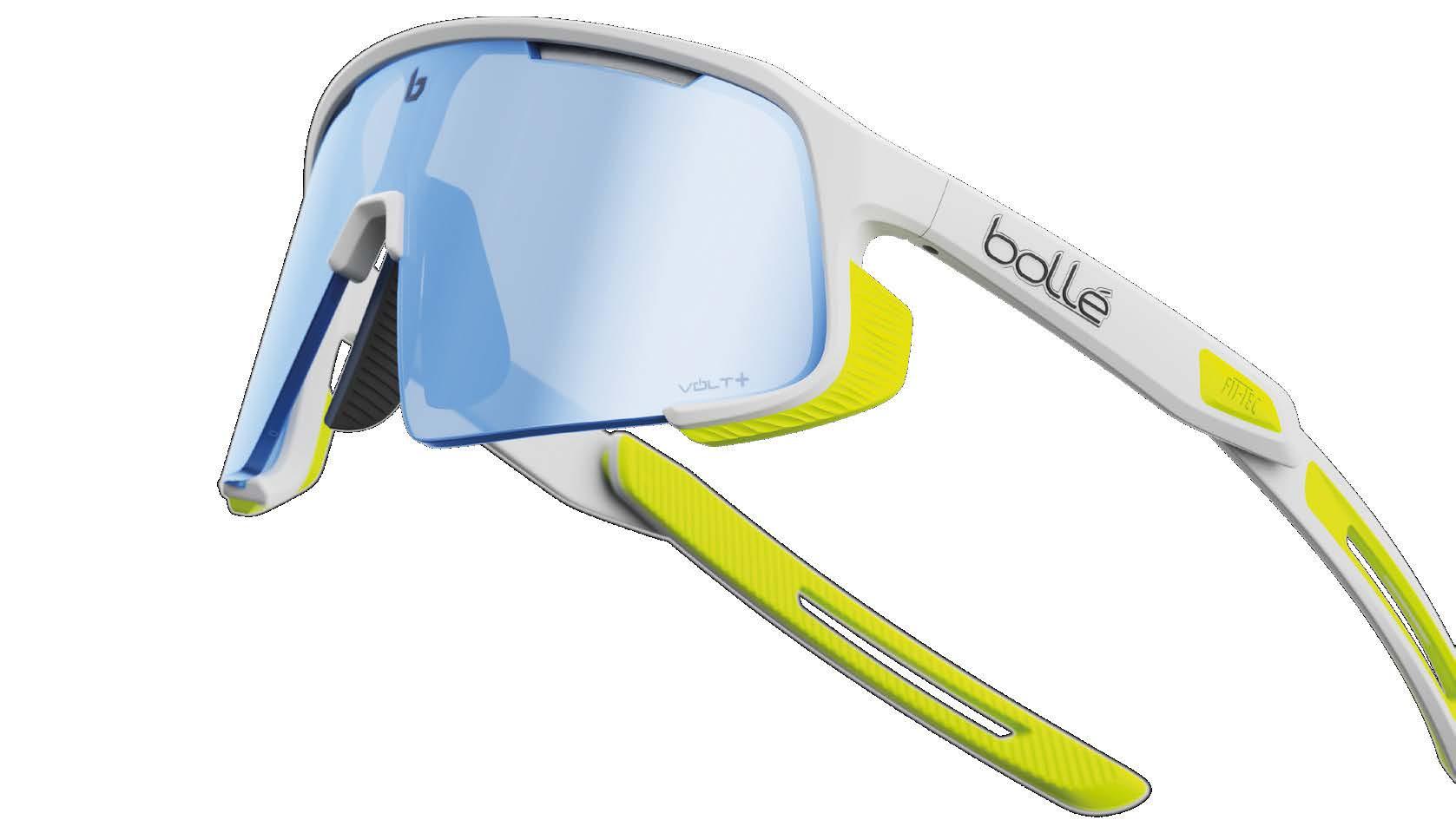
WITH EXCLUSIVE TEMPLE



Kiwi crew return to doublehanded offshore world champs determined to improve on last year’s result.
Yachting New Zealand has confirmed the two teams that will represent the country at this year’s double-handed offshore world
significant experience to their campaign, having raced more than 6000 nautical miles together in two-handed events over the past seven years. They made an immediate impact in the 2022 Northern Triangle - their first multi-day race together - claiming line honours in their division.
The following year, they were first overall on line and PHRF in the mixedteam category of the Round North
They also competed at last year’s world championships in Lorient, France, finishing ninth in their group. Only the top five boats in each flight progressed to the 48-hour final.
Marsh and renowned match-racer Thomson will be competing at the offshore world champs for the first time.
“Last year, Aaron and I gained valuable insights in a highly competitive international offshore fleet,” Merchant






Tips to transform your boat’s balance, speed, and handling - whether you’re racing or cruising.
In previous articles, we explored sail fabrics and types - now it’s time to look at how to use and trim them effectively. While every boat behaves a little differently, the goal remains the same: achieving a balance between speed, control, and comfort, whether you’re racing or cruising.
Sails don’t work in isolation, they interact with the boat’s foils to balance the sail plan’s centre of effort with the hull’s centre of lateral resistance. This balance is crucial to keeping your boat fast, stable, and easy to handle.
Think of the centre of lateral resistance as the boat’s pivot point in the water. If you pushed the hull sideways from that point, it would move directly sideways. Push ahead of that point and the bow dips (lee helm). Push behind it and the stern
dips (weather helm or rounding up). The role of trimming is to adjust the sails to find this sweet spot - minimising helm load and maximising performance.
When reaching or running, the boat performs best with the sail balance positioned forward to unload the helm. Upwind, that balance should move aft to help drive the boat to windward. As a general rule, reduce mainsail area first (e.g. reefing) when sailing off the wind, and prioritise reducing headsail area when sailing upwind to keep drive in the back of the boat.
Sail shape also has a big impact. A deeper sail creates more power - but also more drag - resulting in increased sideways force and heel. A mainsail with deep draft aft will also load up the helm. Excessive heel

pushes the sail’s driving force away from the centreline, increasing weather helm. As soon as the boat is fully powered or overpowered, the priority becomes flattening the sail.
Luff tension (halyard or cunningham): Controls draft position. A loose luff gives

a fine entry and moves the draft aft; a tight luff pulls it forward.
Backstay tension: Controls mast bend and forestay sag. Bending the mast or straightening the forestay removes draft and flattens the sail.
Outhaul or genoa car position: Adjusts foot tension, which affects the overall shape of the sail.
Sail trim is a team effort. Trimmers must work in sync and communicate constantly with the helm to understand the boat’s feel. The best results come from the best teamwork. Below are some general trim guidelines:
The primary controls are sheet tension, traveller position, backstay, outhaul, and the cunningham.
You should use woollies (telltales) mid-sail to check airflow over the sail, and leech ribbons to monitor flow at the exit.
Normal mode: Woollies flying; top ribbon flicking occasionally.
Fast mode: All ribbons flying.
High mode: Top two leech ribbons stalling slightly.
Light air: Traveller up, boom near/above centreline, outhaul and backstay off, loose luff, deep and twisted sail.
Medium air: Traveller down slightly, firm outhaul, some backstay, cunningham on, flatter sail.
Heavy air: Traveller down further, maximum backstay, tight cunningham, very flat sail.
Primary controls include sheet tension, halyard, backstay, car position, and an inhauler (if fitted).
Trim for even break on all telltales. On jibs with leech ribbons, the top one should stall slightly.
Light air: Backstay off, car forward, loose halyard, inhauler on, deep and twisted sail.
Medium air: Firm backstay, car aft slightly, tight luff, inhauler on, flatter shape.
Heavy air: Max backstay, car further aft, inhauler off, tight luff, more twist.
Code Zeros trim more like genoas than
spinnakers. Instead of a car, a tweaker is used to control twist by adjusting the sheet angle. Outriggers are becoming more common to open the slot between the leech and mainsail - especially on planing boats carrying multiple headsails. (Note: outriggers must be mast-attached to comply with racing rules.)
Code Zeros also carry significantly higher halyard loads than headsails. Reducing luff sag greatly increases these loads, often exponentially.
These sails should be eased as much as possible - just shy of collapsing. The luff should curl back gently and continuously. At deeper angles, easing the tack line helps the sail rotate to windward and catch more breeze. Goose-winging can be used in specific tactical situations or to soak down toward a mark.
As with asymmetrics, trim so the luff is just curling back. The pole plays a bigger role here, helping you present as much sail as possible to the wind. Aim to keep the luff nearly vertical, if it floats to windward: bring the pole aft, if it sags to leeward: move the pole forward.
You can also fine-tune stability with pole height and tweakers.
In heavy or sloppy conditions, lowering the pole and tensioning the tweaker will make the sail more stable, but always ease the tweaker again when sailing tighter angles.
Josh Tucker is a respected sailmaker, and experienced offshore sailor. He owns and operates Rogue Sails, specialising in sails customised for every need.
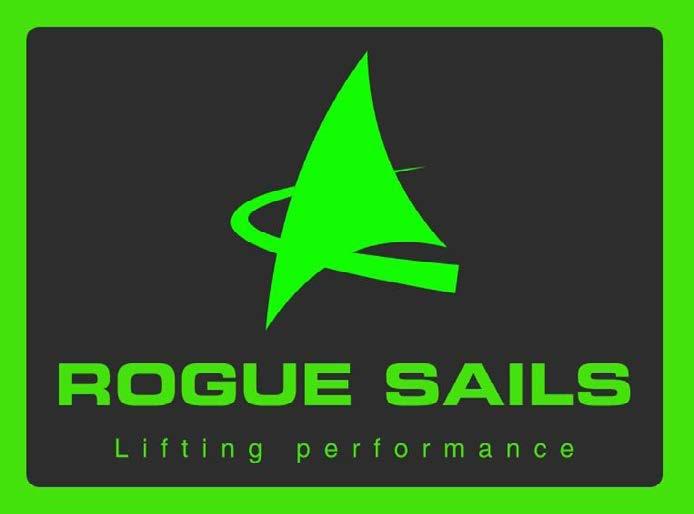

Five simple winter checks to keep your dinghy in top shape for the new season.
With over 50 years in the trade, Mike Pearce is one of New Zealand’s most trusted names in boatbuilding. Since founding Mike Pearce Boatbuilders Ltd in 1994, he’s built, repaired, refitted and refurbished countless vessels, working across both wooden and fibreglass hulls.
Now based in Kerikeri, Pearce specialises in custom builds and maintenance, and as winter starts to bite, he’s urging dinghy owners around the
country to use the colder months wisely.
“The work you do now can make a huge difference to how your boat performs when the new sailing season arrives,” Pearce said. “Neglect it, and you could be facing costly repairs. Look after it now, and it will look after you on the water.”
Here, Pearce shares five key areas to focus on this winter:
The ideal place to store your boat is in a garage, uncovered, or just with a dust cover. The main thing is letting the boat breathe. Moisture is your enemy, especially for older wooden boats that have absorbed seawater over the years. Even fibreglass boats benefit from dry
storage. A carport is a second-best option, but try to avoid any place where rain or humidity can get in. Some people use dehumidifiers, but you’ve got to be very careful - over-drying can open the grain in timber and turn your boat into a sponge when it gets wet again.
These days, most sails are Mylar or carbon fibre - they’re not hard to look after, but the basics still matter. Don’t fold them, roll them. Take out the battens, rinse the sails with fresh water, hang them up to dry properly, then loosely roll and store them upright in a sail bag. Even if you don’t do this after every sail, you should do it before putting the boat away for winter.

As boats get older, rigging failures become more common. You can’t always see corrosion on your stainless-steel hardware, so the best maintenance is

can go black, and then you’re looking at replacing the whole deck, which is expensive. A light sand and spot varnish using a good quality marine varnish
like Goldspar can keep things in good shape. After three or four seasons, you’ll probably need to do a full sand and recoat. Again, good storage makes a big difference - keep it dry and out of the sun.

Building
Our expertise covers:
Olympic & Youth Classes, Foiling Moth, Starling, and Zephyr Classes
Composite production projects and carbon components.
Boat accessories
Spars and rigging supply.
Stockists of high-performance cordage and racing hardware
Foils take a beating - whether it’s hitting rocks, dragging on the beach, or just general wear and tear. Most are fibreglass now, so small chips and dings can be fixed with simple glass repairs and a wet sand using 1200 grit paper. Keeping foils clean is key, especially the centre casegrit acts like sandpaper and can cause jamming or damage the surface. Make sure everything’s smooth and fits well before next season.


Boatbuilding Composites
Marine Systems
Whether you’re starting out or looking at a career change, our pre-trade course offers a practical introduction to the marine trades.
Start your training
February 2026
9 Feb – mid-June
Auckland Campus
Register your interest now – only 12 spots in our workshop-based classes and the chance to connect with industry.

MAST
Academy helps young rigger turn his passion into a profession.
Peter Gamble is carving out a career that takes him from highspec loft work in Auckland to remote boatyards in Southeast Asia - all while completing a formal apprenticeship through MAST Academy.
Based at RigPro in Auckland, Gamble is working towards his yacht rigging qualifiction as part of his training. Renowned for their precision rigging solutions for superyachts and racing yachts, RigPro offers Gamble a hands-on role in the most innovative projects. Their worldwide network, bolstered by North Technology Group’s cutting-edge resources, provide a dynamic platform for Gamble to master skills in diverse, ever-changing settings.
It’s an opportunity that has taken him across the world and tested his skills in a variety of ways, Gamble said.
“I’ve been sailing from a young age, and I was doing a lot of rigging - 29ers, Starlings and 420s.
“I left school pretty early and jumped on superyachts and did yachting for a few years. I slowly started getting into servicing blocks and winches, splicing and doing all sorts of stuff like that. It progressed from there and I realised I wanted to become a yacht rigger.”
No two days are the same, and the role has allowed him to build an impressive range of skills and

experience, both at home and abroad.
“Some of my favourite skills are splicing - I love building loops - and also going up rigs,” Gamble said. “The most memorable work has been overseas. We were in Brisbane for two months, it was beautiful. I had a week in Turkey, and I’ve spent five months in Finland.”
It also means having to think on your feet. “Like when we were in Thailand at a very remote place with very few tools and working in 40-degree heat.
“We were trying to sort this rig out and we only had three days to do it - we had to get welding and fabrication done. Working with different languages and different people is good fun and you always come back knowing more than when you left.”
And with support from MAST Academy, that hands-on learning is backed by formal training.
“With MAST Academy and working on site all the time, it brings it all together. I can complete the qualification and expand my knowledge and my understanding of the job and all the processes.”
For more information about MAST Academy’s pathways and courses, click here.
To find out more or how to apply, email careers@mastacademy.com
A device called Roverseas was one of the technical innovations behind New Zealand’s sailing success at the Paris 2024 Olympic Games.
Asecond-generation device that enables the transfer of data captured on boats during training sessions was a key tool for Yachting New Zealand coaches and sailors in the lead-up to their successful Paris 2024 Olympic campaign.
The Roverseas proved to be a gamechanger in streamlining the analysis of performance data across different training locations, both at home and abroad. Developed through a collaboration between High Performance Sport New Zealand’s (HPSNZ) Goldmine Innovation team and performance and Yachting New Zealand performance analyst Alex Anastasiou, the system played a behindthe-scenes role in supporting New Zealand’s medal-winning sailing efforts.
Isaac McHardie and Will McKenzie claimed silver in the 49er, while Micah Wilkinson and Erica Dawson took bronze in the Nacra 17 in Marseille, where the Olympic sailing was hosted in July and August last year. These results helped push the country’s overall Olympic sailing medal tally to 25 - making it New Zealand’s third-most successful sport at the summer Games.

The Roverseas system was housed in a custombuilt rugged case containing a compact PC and wifi unit, designed to connect with GPS tracking devices known as Rovers. Its purpose was to allow data collected on the water to be transferred quickly and securely into the Yachting New Zealand analytics platform, where it could be interpreted and used by coaches and athletes in real time.
The device enabled Anastasiou to run detailed analysis from New Zealand and provide remote insights to squads training overseas, speeding up feedback loops and improving the efficiency of training sessions.
“Roverseas uses an application we developed to transfer the data captured on the boats during training sessions into the Yachting New Zealand analytics system used by coaches and sailors, providing details of the on-water performance,” said HPSNZ software engineer Steve Brydon.
Brydon adapted the existing app to run on the small PC inside the case, designed to operate without the need for a monitor or any manual oversight. “Now a sailor can simply bring their Rover tracking device and captured weather data ashore, plug the devices into the Roverseas case and expect their sailing data to be available in the Yachting New Zealand analytics system within minutes.”
Physical design was also critical. Goldmine mechanical engineer Bex Cider said the challenge was to create something rugged yet portable enough for air travel.
“It was like a game of Jenga getting our components to fit,” she said. “It was important the six Rovers were housed in a way that was both secure and easy for Alex or the coaches and sailors to charge and download the data from the GPS devices.
“We made a great aesthetic and functional leap between the first to the second-generation units in housing the Rovers themselves. The improvements we made prioritised the experience of the people using the devices and strengthen the perception of their value, increasing their effectiveness and utilisation.”
The Roverseas was one of 63 innovation projects supported by HPSNZ’s Goldmine Innovation team across the Paris cycle. Their work contributed to 16 of New Zealand’s 20 medals in Paris, with innovations reaching across sailing, cycling, rowing, canoe racing, athletics and more. - with HPSNZ
Click here to read more about the work of HPSNZ’s Goldmine Innovation team.
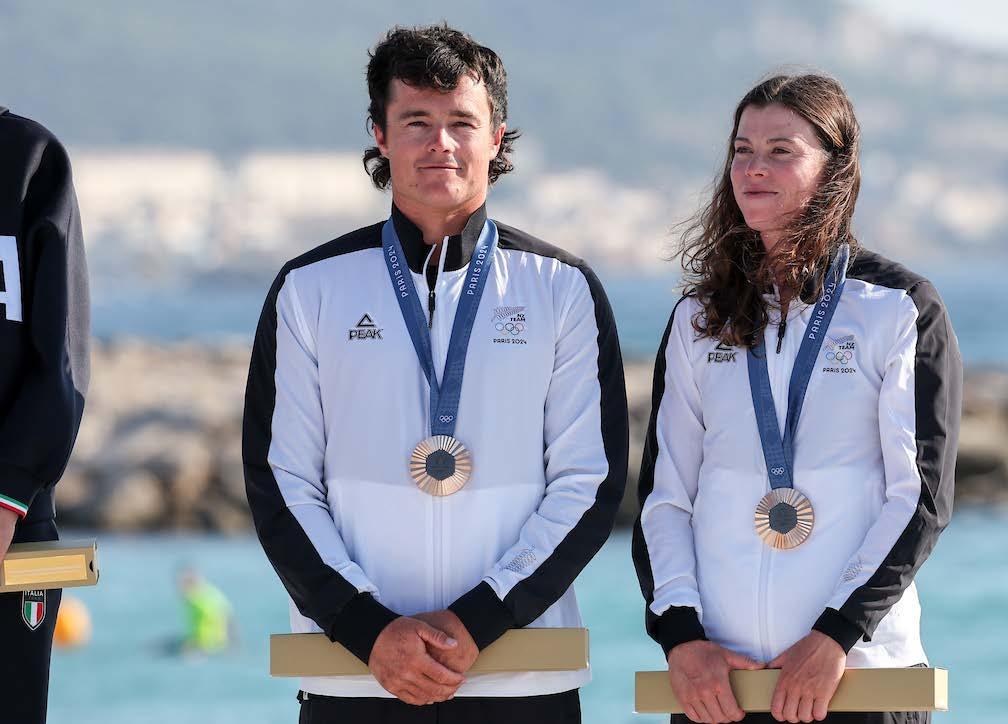

Dirty hulls are becoming an increasingly frustrating issue for many yachties. Kathy Young takes a closer look at the antifouling options in NZ and abroad.
If you’ve been sailing New Zealand waters for any length of time, you’ve likely encountered the frustration of marine growth on your hull. And, according to some boat owners, the growth only seems to be getting worse, given rising sea temperatures and recent regulation changes banning the use of certain biocides.
Understanding antifouling systems and choosing the right products can mean the difference between a season of smooth sailing and costly haul-outs for cleaning.
Antifouling is a protective coating system designed to prevent marine organisms from attaching to your boat’s

hull. It is permeable, unlike household paint - water can pass through it. The active ingredients, called biocides, leach out over time to create a toxic environment that discourages barnacles, mussels, algae and other marine growth from taking hold.
The choice of antifouling paint depends on how your boat moves through the water, the hull material, how you use your boat (racing or cruising), and the sea temperatures you sail in.
Hard antifouling, or contact leaching paint, suits boats travelling at speeds over 20 knots. The coating wears away
gradually from water friction, exposing fresh biocide. Eventually, biocides become trapped in the remaining honeycombed paint film, which needs to be removed by sanding or scraping.
Soft, or ablative, antifouling is formulated for boats travelling at slower speeds - typically under 10 knots. These paints slowly dissolve and slough off, taking any attached growth with them.
A subcategory of soft antifouling is self-polishing copolymers. These contain an acrylic copolymer that reacts with saltwater at the surface of the film, controlling and sustaining the release of
Understanding



biocides. Because this reaction is chemical rather than physical, it occurs regardless of whether the boat is moving or stationary.
Using soft antifouling paint on a fast boat will result in it washing off too quickly. Hard antifouling paint on a slow boat won’t wear away properly and will become less effective.
Professional application usually involves multiple coats, with different colours sometimes used to indicate wear. When the underlying colour starts to show, it signals time for reapplication. A base coat primer provides water barrier protection and typically lasts for 20 years or more.
The issues with both antifouling paints and biofouling relate to the toxicity of biocides to people (during application and removal) and to the environment (as they leach from the paint). Biosecurity is also a concern, as the movement of mature fouling can disperse organisms into new environments.
In 2013, the Environmental Protection Authority (EPA) reviewed antifouling products, leading to the phasing out of substances like thiram, diuron, octhilinone and ziram. Manufacturers must now provide extra
safety information and adhere to rules regarding protective equipment and waste disposal.
Specific regional regulations, separate from the EPA, also apply to prevent the spread of marine pests between harbours. Recreational vessels moving between ports must show evidence of hull cleaning within a defined periodtypically two to four weeks - depending on the destination. This has added further maintenance demands for cruising yachties.
Continued on p42
Continued from p41
Concerns over the environmental impact of traditional antifouling have spurred the development of alternative technologies. These often come with a trade-off between ecological responsibility and performance.
One alternative moves away from biocides entirely. International Paints launched B-Free Explore (pictured), a biocide-free product, in northern Europe where biocidal antifoulings face heavy restrictions. These foul-release coatings work by creating a surface to which marine growth cannot firmly attach. A silicone polymer produces a slick layer, preventing organisms from bonding with the hull. Fouling is then removed by water movement or light physical cleaning.
Repel from Altex is another non-biocide option currently undergoing testing in New Zealand. However, these products are not yet available on the local market.
experiencing significant frustration as the antifouling paints currently available in New Zealand are not working as they used to. They spend thousands of dollars doing a great job on applying antifouling paint, and then within a couple of months, the boat is covered in barnacles again.”
Galbraith is calling on regulators like the EPA to allow New Zealand access to biocide-free products used in Europe and supports more regular boat washing, which he believes “would be beneficial to everybody”.

The New Zealand Marina Operators Association (NZMOA) has called for urgent regulatory reform to allow safe alternatives into the country.
“Generations of boaties have grown up with the knowledge that paints can perform to keep your hull clean, but we recognise the landscape has now changed,” said Chris Galbraith, NZMOA chair and general manager of Bay of Islands Marina.
“However, our members are
Non-biocidal solutions have limitations, though. They require much more frequent cleaning than traditional antifouling, depending heavily on local fouling conditions. Some areas may need cleaning every few weeks instead of annual or biennial haul-outs. Widespread adoption may also require changes to marina infrastructure and maintenance habits.
“While alternative solutions offer promising benefits, it’s important for boat owners to understand that they still require some level of ongoing care,” said Adrian White, AkzoNobel Yacht Coatings regional sales manager for New Zealand.
“Regular use or periodic cleaning will help ensure these solutions are effective and maintain the vessel’s condition.”
Continued on p44

Alex Cuthbert, owner of Waterline Marine Services, Lyttelton, has been working with antifouling paints for over 20 years.
He antifouls approximately 30 boats annually while maintaining his own fleet of yachts.
According to him, antifoul performs as advertised when owners match paint to purpose and apply it correctly.
The failures he sees aren’t paint problems - they’re typically preparation and application problems.
“When applied correctly, I’ve had no problems with antifoul paint lasting as long as I’d expect it to across all the major brands I use - Altex, International Paints, Carboline,” Cuthbert said.
“It’s surprising the number of boat owners who still apply their own antifoul and, in a lot of cases, don’t do it correctly.”
Owners often follow the same flawed process - haul out, waterblast, light sand, roll on new paint - then wonder why it fails prematurely.
“They don’t properly remove what’s left of the old existing paint and prepare the surface properly,” Cuthbert said.
Even worse, he’s witnessed boaties painting different types and brands over each other, which simply doesn’t work, and on one owner who started painting before the hull was dry.
Cuthbert uses different strategies based on specific conditions and usage patterns.

Most problems with antifouling performance are as a result of incorrect preparation and application, says Alex Cuthbert.
Preparation is key: It’s no different to painting your house - you can’t just paint over old stuff and expect it to hold on.
Remove old paint completely, don’t just sand lightly.

Ensure the hull is completely dry before painting.
Thin paint 5 per cent with manufacturer’s thinners for better flow.
Use solvent-resistant rollers. Never apply on hot days – “it skins off so quickly”.

Apply extra coats on the rudder, keel, and bow area where water flow is fastest.
Never mix different paint types or brands. Use antifoul sealer over unknown previous coatings or find out what was previously used.
White also believes a more integrated approach could be beneficial, such as marinas offering underwater washing stations to support environmental sustainability and biosecurity efforts.
Dr Chris Hill, the EPA’s general manager of hazardous substances and new organisms, explained that hazardous substances must be approved under the Hazardous Substances and New Organisms Act 1996 before they can be imported, manufactured, supplied or used.
“Our role is to receive and assess applications to approve the import or manufacture of new hazardous substances, and to set the rules to manage their risks,” Hill said.
“As of now, the Environmental Protection Authority has not received any applications to import or manufacture biocide-free products such as B-Free Explore.”
Most marine paints, resins and varnishes fall under the EPA’s Surface Coatings and Colourants Group Standards, which set out conditions for safe use. However, biocidal antifouling paints are excluded from these standards and must be individually approved by the EPA.
A few products have made it through the regulatory process. Hempel’s Silic One (pictured) and Hempagard X7 are biocide-free, fouling-release coatings based on silicone. A hydro gel micro layer creates a smooth, low-friction surface that prevents organisms from attaching. Suitable for GRP, alloy, steel and plywood hulls, the products claim a two-year service life.
Hempel’s Business Development Manager (Marine and Protective), Duncan Crawford, says the Silic One and Hempagard X7 products has been permitted by the EPA, although the process to get there has been “very difficult”.

Propspeed is another biocide-free foul-release system, designed to protect underwater metals such as propellers, shafts and rudders. It forms a hydrophobic surface that prevents marine growth from adhering. Fouling is removed through water flow or light cleaning. It improves performance, reduces maintenance, and has less environmental impact than traditional paints.
A selection of antifouling options are currently available in New Zealand, through various independent local and national retailers.
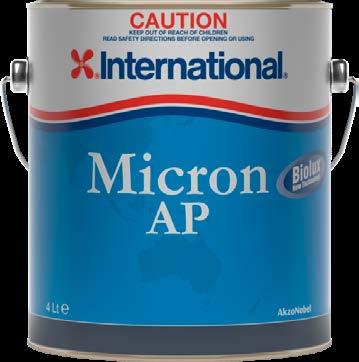
Manufacturer: International
Type: Polishing
Suitable for aluminium? No Maximum strength antifouling. Contains boosted biocide levels. Suitable in all environments. Suitable for the widest variety of vessels.
$599.99 for 4 litres
Biocide-free antifouling paints do not currently meet the definition of an antifouling paint under the Group Standards, as they contain no biocides. However, a biocide-free product can still be assigned to a Surface Coatings Group Standard by an importer or manufacturer, if it meets the required conditions. In these cases, an application for new hazardous substance approval may not be necessary.
“The availability of these products depends on whether and when an importer or manufacturer chooses to assign them to an appropriate Group Standard and bring them to market,” Hill said.
Coppercoat MultiSeason Antifoul Coating is a two-part epoxy rather than a paint. It is solvent-free, does not leach biocides, and, according to its New Zealand distributor Hullwell AMCT, is the only antifoul coating in the world with non-hazardous classification. It claims to offer protection for 10 years or more with minimal maintenance and haul-out costs.
Ultrasonic antifouling systems are also available. These use sound waves to create vibrations on the hull’s surface, which may prevent larvae from settling. However, the NZMOA’s Galbraith remains sceptical: “I’ve heard stories of people trying all sorts of alternatives, including adding their own additives to the antifouling paint in order to keep organism growth at bay.”

Manufacturer: International
Type: Polishing
Suitable for aluminium? No High-strength antifouling. Contains boosted biocide levels. Formulated to provide improved resistance to slime.
$419.99 for 4 litres
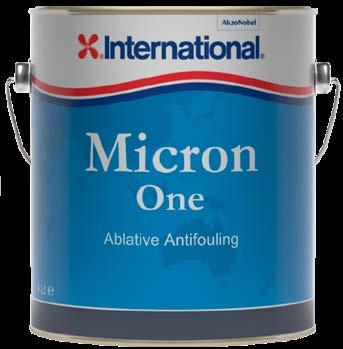
Manufacturer: International
Type: Ablative
Suitable for aluminium? No
Seasonal ablative antifouling.
Economical and dependable. Designed to erode with use, which reduces paint build-up and sanding.
$259.99 for 4 litres

Manufacturer: Altex
Type: Ablative
Suitable for aluminium? No
Ideal where multi-season fouling protection is needed.
Compatible over other copper-based antifoulings.
Available in four colours.
$299.27 for 4 litres

Manufacturer: Hempel
Type: Polishing
Suitable for aluminium? No
Controlled, predictable polishing rate and biocide release.
Suitable for vessels with hull speeds up to 20-25 knots.
Thinning not recommended.
Available in three colours.
Application by airless spray and brush.
$399.99 for 5 litres

Manufacturer: International
Type: Hard
Suitable for aluminium? No
High-strength, hard antifouling.
Suitable for fast power boats and competitive sailing.
Hard, scrubbable finish. Fast-dry formula.

Manufacturer: Altex
Type: Ablative
Suitable for aluminium? No
Multi-season protection.
Water-based, so clean up with soap and water.
Low-odour formula and easy to apply. Contains drag-reducing PTFE (non-stick coating).
Unlimited dry time to launch.
$571.49 for 3.78 litres
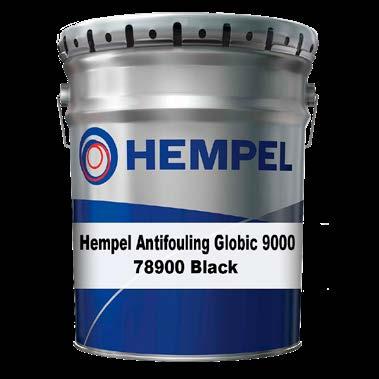
Manufacturer: Hempel
Type: Polishing
Suitable for aluminium? Yes
Controlled, predictable polishing rate and biocide release.
Smooth finish, reducing drag and improving fuel efficiency and speed. Can be used on propellers and stern gear.
Performs like a hard antifouling.
$489.00 for 5 litres

Manufacturer: International
Type: Polishing
Suitable for aluminium? Yes
Avoids seasonable paint build-up.
Available in bright colours.
Formulated for use on aluminium.
$419.99 for 4 litres

Manufacturer: Altex
Type: Hard
Suitable for aluminium? Yes
Available in six bright colours (including black and white).
Hard-wearing, ablative.
Suitable for any boat, ideal for trailering and racing.
$359.99 for 4 litres

Manufacturer: Coppercoat
Type: 2-part epoxy
Suitable for aluminium? Yes
For multiple types of vessels and uses. Protects against substrate degradation and fouling for 10+ years.
Minimal maintenance and costs.
Non-porous and highly durable. Doesn’t leach biocides.
Exclusive non-hazardous classification. POA - visit hullwell.co.nz

VMG Clothing is the manufacturer of elegant, highperformance crew wear for the superyacht and marine industry and also the proud clothing partner for Yachting New Zealand. Now, for the first time, club members can access the exclusive VMG range of NZL Sailing -branded gear via our website.








Chatham Backpack $145
Unisex (white)
25L volume waterproof backpack with adjustable straps, safety clasp and front zipper.
Chatham Gear Bag $169
Unisex (white)
65L volume waterproof gear bag with adjustable straps, safety clasp and front zipper.
Coaches Tech Jacket $395
Unisex (black)
Tested to withstand 40,000+mm of water over 24 hours with double seam-seal adjustable hood.


Tekapo Polo $85
Men’s and women’s (black/titanium)
Slim fit with moisture wicking and selffabric engineered collar with three-button placket. Recycled plastic fabric.
Moana SS Tee $76
Men’s and women’s (charcoal/white)
Lightweight, stretchy and breathable made from recycled plastic. Protects you from the sun and acts as a moisture-wicking layer.
Sandspit Hat $58
Unisex (black/white)
Wide brim sun hat with regular fit. Adjustable cord and sweatband lining.
Hauraki Shorts $133
Men’s (charcoal)
Quick-drying performance garment with stretch, made from recycled plastic, water-repellent fabric, adjustable waist and side cargo pocket.
8 Ozone Cap $26
Unisex (black/white)
Regular OSFA fit with crown peak cap, black Velcro strap and clip cord.
To view the full range and to make a purchase, click here




Kiwi sailor’s 55-year love story with a boat named Diablo 66


What to ask for, where and how 74

From foundry to the hot seat 80
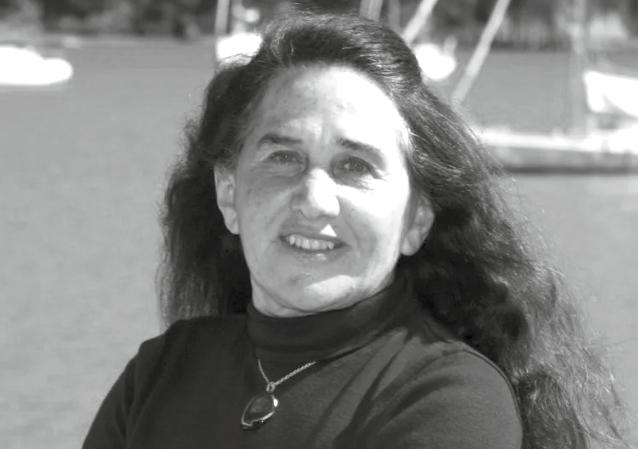
Lin Pardey FROM THE COCKPIT
The ‘perfect ending’ to a wonderful voyage around the southern tip of Tasmania almost turned to tragedy.
“Whatever it is you’re doing down there, forget it,” David shouted. “Be quick. You need to see this.”
Though we’d voyaged together for less than a year, I now know David well enough to realise, this is not an emergency. But still, I move quickly to turn off the burner under the soup, tighten the clamps holding it on the gimbled stove, then put the hot loaf of fresh bread on a non-skid mat to stop it from sliding off the counter.
The sight that awaits me is breathtaking. A quarter mile ahead, a half dozen huge dolphins dash about in a frenzy, leaping into the air, twisting, churning the sea around them into a white froth. “Did you grab your camera?” David yells as he begins climbing out of the cockpit to get a closer look.
I marvel at the dolphins’ antics. My first thought, “what a perfect ending to a wonderful cruise.”
I don’t have time for a second thought.
A fierce wind knocks Sahula almost flat. Laying on her beam ends, she still slices forward held on course by the self-steering vane. Dollops of salt water begin lapping over her cockpit combing.
“Run her off,” David yells over the roar
of wind, the crash of rushing water. He scrambles back into the cockpit and slides across to the leeward sheet winch. I climb past the steering pedestal, grab the wheel and struggle to fight the leverage of the windvane rudder.
Tasmania, situated well into the “roaring 40s”, is subject to challenging weather. No matter the season, low-pressure systems which march around the bottom of the world unhindered by any land, intensify when they run into the mountains of this rugged island. Because the lows move slower during the summer season, by keeping a flexible schedule, David and I had almost two months of enjoyable sailing as we meandered south through the D’Entrecasteaux Channel on the eastern shore of Tasmania.
As the autumn days grew ever shorter, David began monitoring the approaching weather systems using his ham radio. Just when we were feeling sated, the forecast promised a 15 to 20 knot northeasterly, slowly backing all day long.
If the report was correct, it meant we’d have a beam reach for each of the three legs of the 55-mile trip around the bottom of and back into the shelter of the east coast.
We were underway just at daybreak on a fresh northeaster. Sahula is at her very best with winds of 15 knots. Her windvane selfsteering works wonderfully if she has two reefs in the mainsail and her large Yankee (reacher) set.
When we cleared Port Davey, we found there was only a hint of the southwesterly swell that is normally a constant on this coastline. Sailing couldn’t have been better. Once we were comfortably settled in for the first 17-mile reach towards South West Cape, I decided to cook up a hearty soup and bake some bread to go with it.
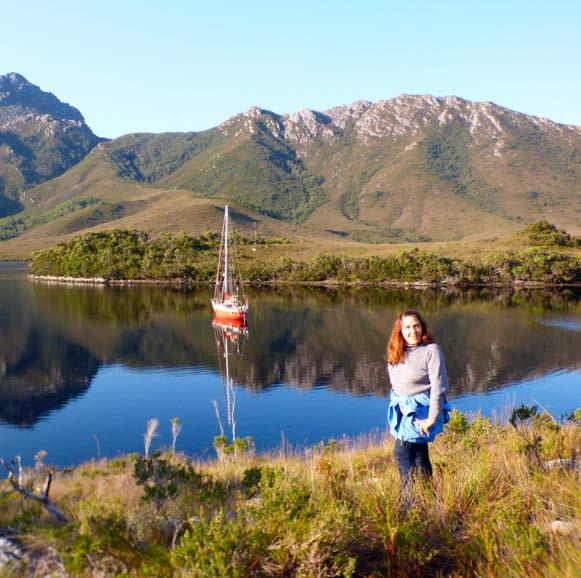
As autumn approached, we’d grabbed a light weather patch to head around the southern tip of Tasmania and reach the splendid isolation of Port Davey on the wild west coast.
Larry and I had sailed here several years before, bound westward toward the Indian Ocean. During this second visit on Sahula, I had a sense of déjà vu as David and I trekked along the shoreline where wombat tracks were the only way to get through the dense undergrowth.
We took dinghy forays up river gorges. I enjoyed the solitude on board in a perfect keyhole anchorage while David scrambled over jumbles of rocks to climb Mount Rugby, the highest local peak.
Little had changed in Port Davey between those two visits. Larry and I had encountered only one other visiting yacht and three commercial fisherman who shared weather information with us. Now, almost 25 years later, during our two-week stay, David and I encountered two other yachts, but no fishermen.
The wind soon began to back just as forecast. By the time we had to alter course to head due east around the tip of South West Cape, the wind was out of the north. We’d allowed for a comfortable offing. We didn’t want to be too close to shore where the steep chain of mountains lining Tasmania’s west coast might blanket our wind and leave us becalmed.
We hadn’t considered the alternative.
Now, as the wind screamed and Sahula dragged her topsides through the water, David seemed to take forever to reach the leeward side of the cockpit, though in reality it was seconds.
“Grab hold of the sheet,” he yelled as he pulled it out of the self-tailer. Before I could steady myself enough to reach over and grab the sheet, it pulled loose from the winch and the sail began to flog madly.
The sound was almost overwhelming, the shaking of the boat transmitted right through my arms as I struggled to steer her off. The wind continued to scream at gale force. But now, without the pressure of the headsail I was able to overcome the power of Sahula’s self-steering rudder. She slowly bore away and came more onto an even keel, rushing downwind at 7 knots with only the double reefed mainsail driving her. David scrambled to the windward side
of the cockpit and grabbed the headsail furling line, got it around the sheet winch and began cranking. Forgotten were the dolphins which now leapt and gallivanted just feet away from us.
All that filled my mind was the terrible sound of the flailing headsail.
It felt like a horrendously long time until David was able to furl the Yankee. And seconds after it furled, the gale force wind, the noise, the white water and the dolphins left us.
We sat shaken and becalmed. Neither of us moved or said anything for several minutes, even after the wind settled back into a 15-knot northerly.
As David once again unfurled the Yankee and got it pulling, I went below to pick up the loaf of bread that had leapt off the counter and re-light the fire under the soup.
Then we began dissecting our mistakes.
We’d both spent time sailing close to steep mountains, in the fiords of Norway, in Patagonia, in New Zealand’s Fiordland. There we’d constantly been on watch for williwaws.
South West Cape is sheer sided, just like the mountains of those fiords, yet we’d never considered the possibilities of williwaws here.
When the williwaw hit, I hadn’t thought to let the headsail fly - I could have, should have. I was right next to the winch when we got knocked almost flat.
Then, as we began to sail onward, we both looked back to where the dolphins still cavorted.
Our real mistake became obvious.
In our delight at the dolphins’ antics, we’d missed the information nature was providing.
The churning white caps had nothing to do with the dolphins - it was the warning of a full-fledged williwaw.
We might have been out in the cockpit looking around, but we definitely were not “on watch”.
Lin Pardey is an American-Kiwi cruising sailor and best-selling author known for her circumnavigations with late husband Larry. Now based on Kawau Island, Pardey is voyaging again with sailor and environmental law lecturer David Haigh.
This column first appeared in Cruising World Magazine and is republished with permission.
In the latest instalment of her series on the origins of quirky boat names, Kathy Young explores the story behind Unhinged.
Some yacht builds start with grand ambition and big budgets.
Others begin with a $200 spur-of-themoment purchase and a hefty dose of what can only be described as madness.
Enter Unhinged, a 10-metre Colin Cook design that’s been turning heads and providing its owners with plenty of smiles.
either side of it to bring the beam down from 3.1m to the regulation 2.95m.”
It was major surgery, but they knew what they were getting into.

The boat’s original mould had been gathering dust for years in Christchurch after an untimely passing.
“We found it on TradeMe in 2022,” said John Stalker, co-owner of Unhinged with Hamish Jackson. “It’d been sitting around for years in a shed. We bought it for $200 and then went ‘what have we done?’.”
What the Wakatipu Yacht Club pair purchased was essentially a 10-metre hull still sitting in its mould and what followed was a massive undertaking that would consume the next two years of weekends.
The rebuild presented typical challenges - new component costs were “horrendous”, so the pair bought a donor boat and stripped its carbon parts.
“This way we were able to spend a quarter of the price, I reckon,” Stalker said.
Naval architect Kevin Dibley joined the project, providing crucial professional expertise for the mast setup, rigging and keel configuration. The donor mast was extended to 12.5m (just short enough to be man-handled up as a trailer yacht), supporting an impressive 200sqm of sail area when running.
The name pays homage to Colin Cook’s smaller 7-metre design called Unleashed - the only other similar design in trailer yacht racing. But it also reflects the project’s ambitious scope and the reaction it generated:

The boat required extensive modification just to meet trailer yacht regulations, which had changed the year before their purchase. It also required a trailer.

“We had to cut the sides off it,” Stalker said.
“We took 75mm off
“A lot of people came to us and said, well, we’re stupid!”
After two years of construction and two years of racing, Unhinged has proven its worth on the water.
“It’s a fast boat, and I believe it’s the largest trailer yacht in New Zealand,” Stalker said.
“Its waterline length advantage allows it to compete with the modern superlight powerful trailer yacht designs.”
From a $200 mould to a racewinning yacht - perhaps being unhinged isn’t so crazy after all.
‘Like so many Kiwis, my connection to our coastlines and beaches runs deep - from childhood days on the water to watching my daughter recently discover sailing for herself’
Steve Armitage









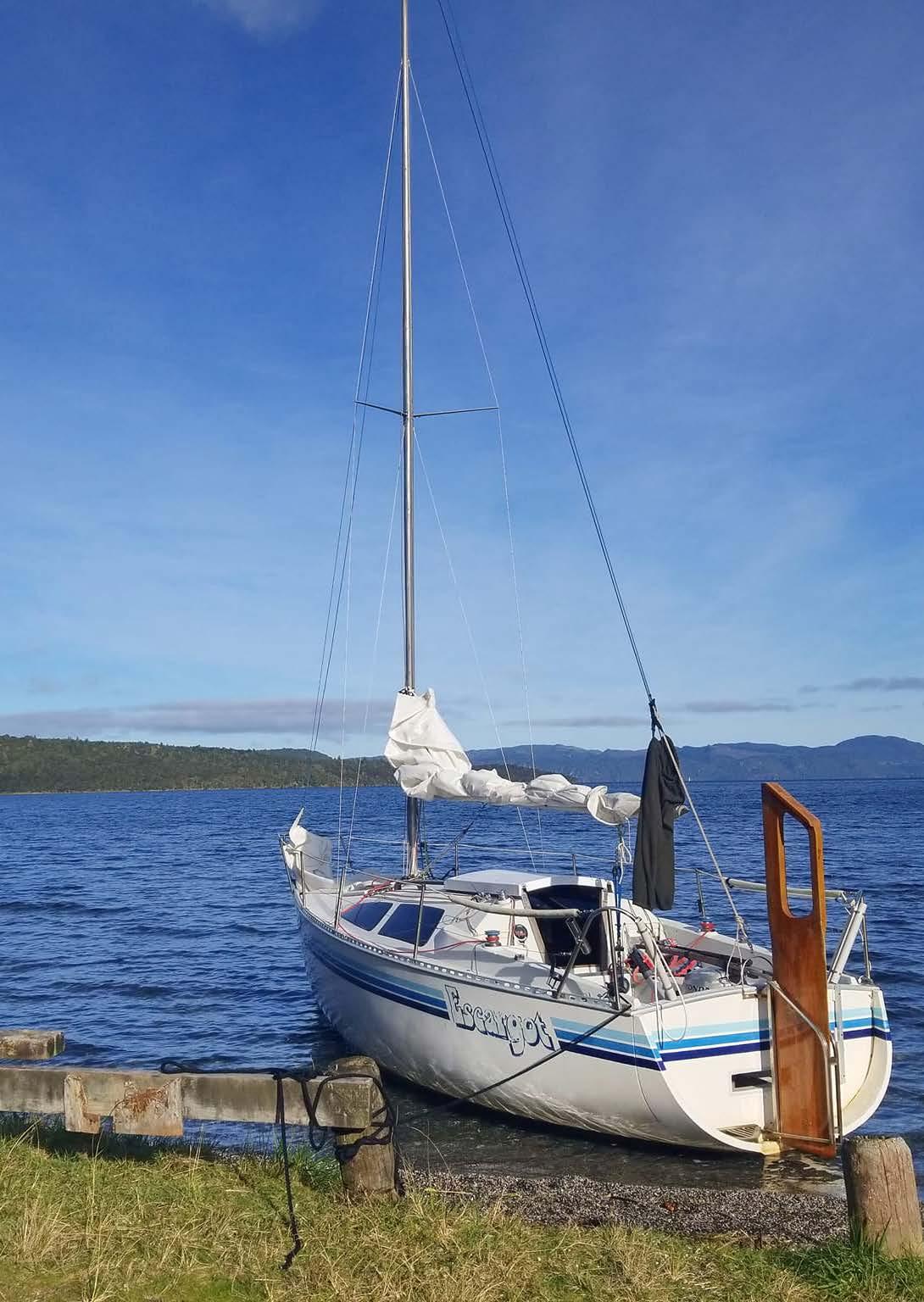

Seven years ago, seasoned trailer yacht sailor Wayne Holdt rediscovered the joys of cruising on his Noelex 25 while still racing his beloved Hartley 16 at the New Plymouth Yacht Club. Here, he shares everything you need to know about these boats.
Trailer yachts offer the best of both worlds - the freedom to go cruising as well as fun racing - with the added flexibility to explore new destinations without being tied to one marina. This A-to-Z guide, first published in 2022, has been refreshed to help new owners navigate the steep but rewarding learning curve and make the most of everything trailer yacht cruising has to offer.
Your ‘ground tackle’ will be made up of an anchor, a length of chain (at least as long as your boat) and the warp, usually three-strand nylon rope long enough to be at least seven times the average depth of the water you expect to anchor in, probably longer in lakes. Your chandler can advise what size chain, rope and anchor is best for your boat, but generally I find that it’s best to use the strongest and heaviest you or your crew can manage. As a guide, I use a Danforth (above) S10, 8m of 8mm chain and 100m of 10mm warp on my 7.8m yacht. Also, when anchoring, make sure you don’t reverse faster than the person on the bow is able to let the rope out, knots, etc.

of available options - get one with a solid structure as it will get blown around.
Boom tent
These can be as simple as a tarpaulin. I prefer a system where the sail battens run from each side to create a curve. This gives you more room and the feeling of not being closed in while still being able to see out and talk to the boats next to you. White material lets a lot more light in. On the smaller boats like the Noelex 22 you can also make a false gooseneck which slides up the sail track and creates more head room. If your boat has a short boom, you can slide a piece of alloy in the outer end and reconnect your topper to the end of it to get a longer boom tent (above)

Yachting New Zealand has three different safety standards, depending on the type of sailing you do. Category C applies to trailer yachts sailing in substantially enclosed waters under the direct supervision of a club or squadron and in the presence of other craft. If you’re heading up to the Hauraki Gulf or Bay of Islands, you should look at Category B or A. For the comprehensive list of category C requirements, click here (the regulations for trailer yachts start on page 82).
Make sure your battery is in a battery box and is well-secured.
Bimini
A Bimini top is an open canvas structure that provides shelter in the cockpit. It sits over the cockpit and is supported by metal frames, and you will need to fold it back to go sailing to ensure you can access the mainsheet. You also need to make sure you have enough room to mount your solar panel. There are plenty

The anchor chain has two functions - it is resistant to chafing against rocks at the bottom that would otherwise cut your anchor line, and its weight also helps the anchor to maintain its grip, as its weight will be pulling closer to horizontal.
Most condensation occurs in the front V berth of your boat. A small triangular cover (left) will help reduce condensation if mounted off the deck.
Continued on p58
There are many types of anchors, but the Danforth and plough (CQR) are most commonly found on trailer yachts. Most carry a Danforth because it folds relatively flat and is easy to stow. The tips of the flutes on a new Danforth can be very sharp and may need to be ground off a bit. The plough provides the best holding in most conditions. It’s good practice to carry a spare anchor.
Some of the equipment required on board, in case of emergency or to help prevent one, includes a radio receiver for weather reports, a marine VHF (recommended), a second form of communication and a properly mounted fire extinguisher and flares.
Fenders are a must-have. Again, there are a few types: some are round and inflatable and others are flat and made of cell foam.
These will need servicing if you have them. This means taking them apart, removing the old grease with degreaser and then regreasing them with winch grease. Be careful when taking it apart so you don’t lose the little springs that hold the flippers. You can watch an example of how to service a winch in the video above. Designs
The NZTYA has approved over 160 trailer yacht designs, with the Ross 780, Tasman 20, Jim Young trailer yachts, Farr 6000, Farr 5000, Noelex 22, Trojan 750, Hartley 16, and Noelex 25 a few of the most popular. For a complete list, click here.

A dodger (above), also known as a spray hood, is a frame-supported canvas structure that covers part of the cockpit and the entrance to the boat’s interior. It’s more practical than a bimini but reduces visibility and you will need to consider if it needs to be folded forward to allow you to use your winches and jammers.
keel down - especially when it’s windy. Many people have trouble with the winch wire snapping on a swing keel, and most are now replacing the wire with Dyneema rope. If using an electric keel winch, it would be a good idea to have some sort of manual override in case you have an electrical problem.

A lot of trailer yachts have changed to Spectra halyards as the old wire ones have broken. For most boats around 6m, a 6mm Spectra rope is sufficient. For a 7.8m boat, you may require an 8mm rope. Make sure you secure your halyards away from the mast to stop them banging against the mast when not in use, especially at night. If you have hanks on your jib, consider running a small line from your cockpit up to the bow and then up through the jib hanks and tied to the head of the jib. This makes lowering the jib from the cockpit much easier.
Yachting New Zealand’s recently published Introduction to Sailing - Level 1 (right) is recommended reading for anyone wanting to know the basics of sailing a trailer yacht, keelboat or dinghy. Click here to get your copy.
There are plenty of options, but it would be useful to check what others use on a boat comparable to the one you have. Jacklines (right) are a must for singlehanded sailing.
An easily accessible and correctly sized lifejacket for each person on board - adults and children - must be worn while racing and while under sail when cruising. A whistle and light are also recommended, if available. Lifejackets with a crotch strap for inflatable jackets is optional but recommended.
Lighting
These inflatable solar lights (left) are great for the cockpit and last for ages. White cabin lights tend to attract lots of bugs, so consider a red light to try to slow the number of bugs in your cabin. I put red duct tape over white LEDs which works well.
Lines

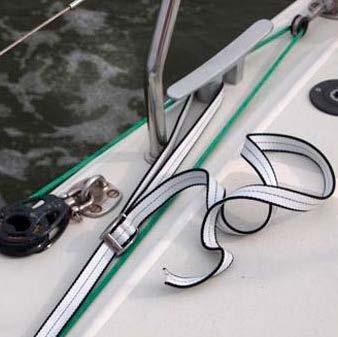
Make sure you’re able to lock your
Trailer yachts commonly have one bow line and two stern lines. The bow line needs to be long enough to reach the cockpit so docking on jetties is a little easier. Bow and stern lines are used on all boats and in all conditions when tying up. These lines run forward from a fixed point (usually a horn cleat) at the bow, and aft from a cleat at the stern. Bow and stern spring lines run aft from the bow and forward from the stern. They prevent the boat from surging forward and back when the area is affected by swells or passing boats. Spring lines are also used to help bring the boat alongside the dock or pull the bow or stern away from the dock when under power. When anchoring at a lake, you can power back to the beach and secure two stern lines to the shore to stop the boat swinging. These lines need to be quite long at some venues.
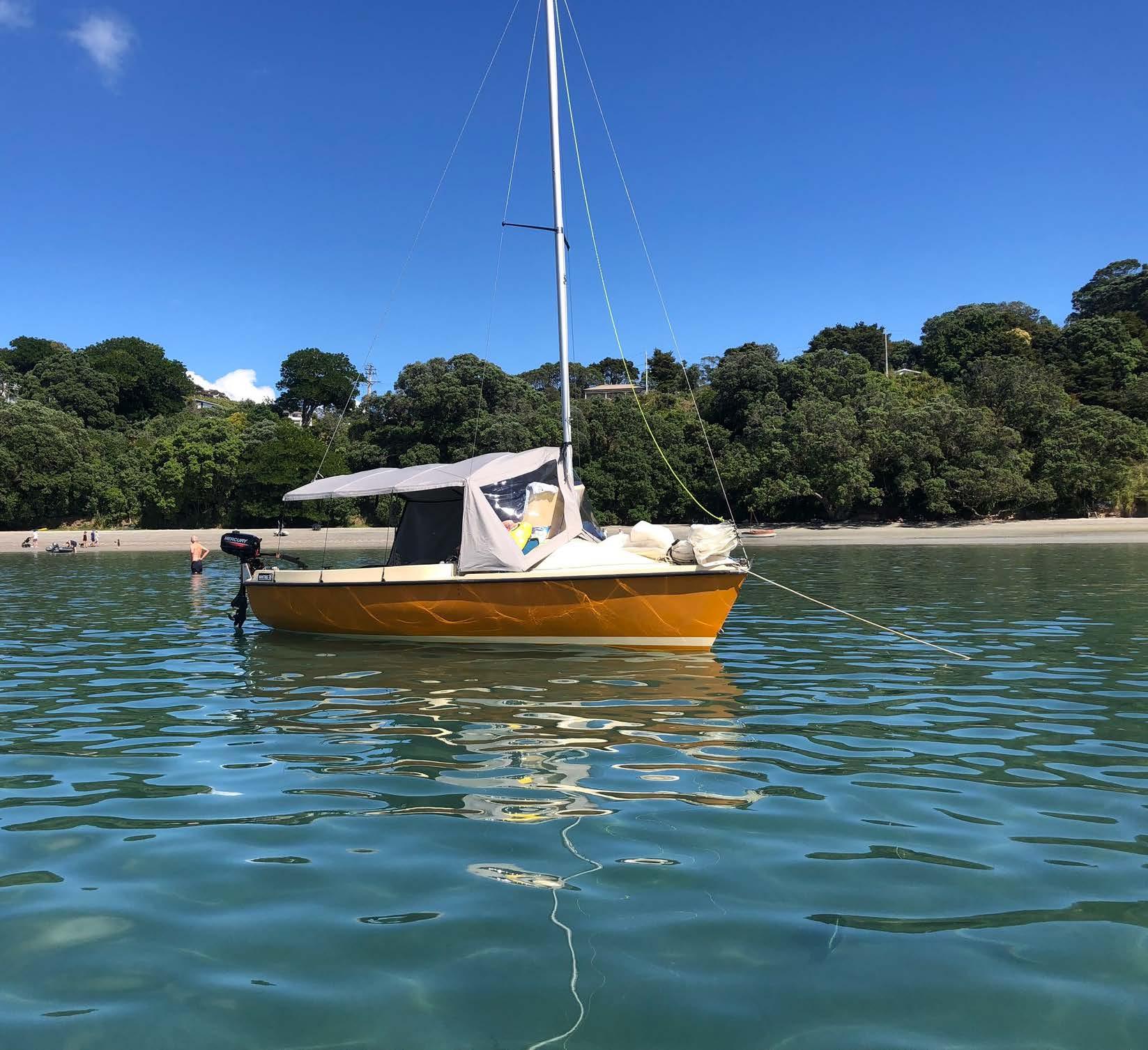
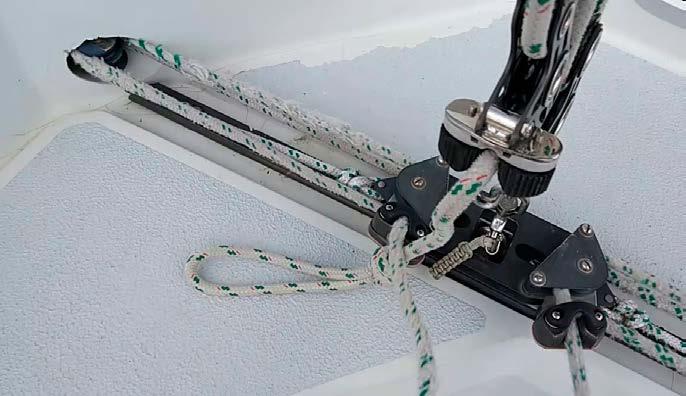
While these are a must-have for racing, some cruisers have removed these travellers (above) to create more room in the cockpit, especially when using a boom tent. You could set up a system where the mainsheet is snap shackled at both the floor fitting and boom so it’s easy to move it out of the way when you are at anchor. Use a
flush mounted eye as these are great on the cockpit floor to save your toes!
Mainsail
Make sure you are head-to-wind before trying to pull the mainsail up or lowering it.
Recommended equipment include a reliable compass and navigation lights that are fitted and operational on all yachts sailing/motoring after sunset. I have been using a solar garden light as an anchor light at the mast head for a few years now which seems to work fine.
NZTYA
The NZTYA assists squadrons, clubs and trailer yacht sections of clubs and class associations to coordinate trailer yachting
within their respective memberships.
There are many cruising publications available. Below are a few good ones - most can be found online or in bookstores:
• Pickmere Atlas by A. H. Pickmere and Janet M. Watkins
• Royal Akarana Yacht Club
Coastal Cruising Handbook
• New Zealand’s Hauraki Gulf by David Thatcher
• New Zealand’s Northland Coast by David Thatcher
• Island Cruising Association cruising guides
• Boat Books

Continued on p60
RRig tension
Firm is best. Ask others what they think or check out similar boats. Remember to let your rig tension off if you leave your rig up. It’s not unheard of for the mast step to compress if you don’t do this. Rudder
Rudders on cruising boats are often hard to get up and down. Most use a rope pull-down and pull-up system (right), but this can be hard to operate if the rudder is tight in the rudder stock. A Teflon washer or ice-cream lid on either side can also work. Rudder angle is also very important as your rudder only has to move a small amount aft at the bottom to create a lot of pressure on the helm (weather helm - making the boat want to turn into the wind). If your rudder is fully down and is still hard to steer, you may need to rake your rudder forward slightly. The first time I sailed my boat, the rudder was very heavy, so I drilled a new pivot point in the rudder. I went from battling to steer the boat to being able to use two fingers to steer in any breeze. You can attach a pull-down rope to the front of your rudder. Check there is enough clearance between the front of the rudder and the inside of the rudder stock

for the rope, then lead it to a cleat on the tiller. This may not need any purchase. The rudder pull-up will need some purchase. The lower down the trailing edge of the rudder you have the pullup point, the better. If you’re racing the boat as well, you won’t want it in the water so it will be a compromise.

boats. On a ply boat, make sure you sand back to solid timber and then use epoxy to fix the spot.
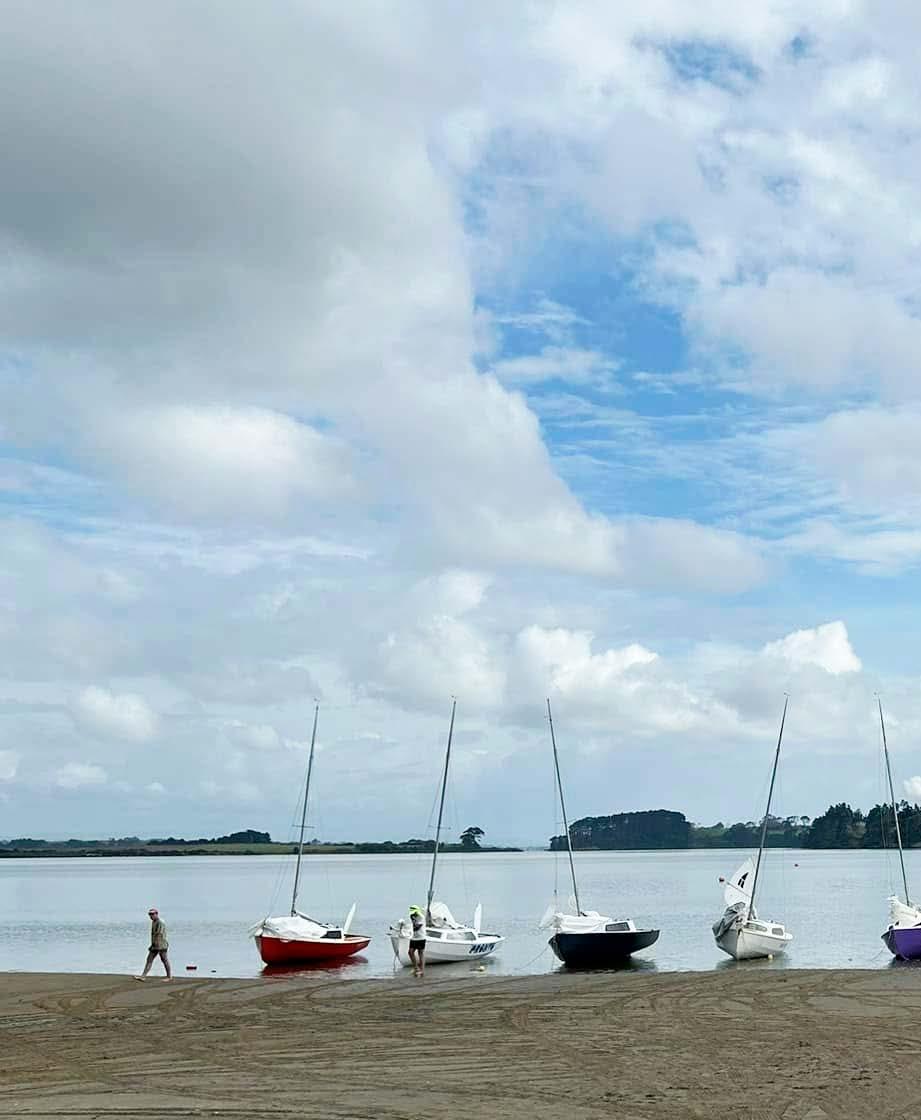
Know the rules of the water you sail on. This includes the rules of the road, at sea, as well as the local lake rules and harbour bylaws.
If you have a selftacking jib and don’t want the jib sheets to cross your front hatch, which is common on Ross 780s (top), then check out the Noelex 25 system (right) Soft spots


These can appear wherever water has been sitting, or under stanchions and fittings. It’s a long job but removing all fittings and resealing all bolts and fittings will make a difference in the long run. Gelcoat is best for cosmetic chips on fiberglass
This is easily the best option for cruising yachts but it’s sometimes difficult to know what setup to go with because some are excellent and others fail to meet your needs. I was lucky enough to meet some people familiar with solar power while away cruising on their Noelex 25. They had recently installed a unit which worked so well I copied it. I bought a 50-watt solar panel, 4mm cables and the MPPT controller, 100-amp hour deep cycle battery and 40 litre ICECO fridge bin. I have been really pleased with the unit and have not run out of power, even after 10 days away. There are a few things to check with items like fridges: the vents at the bottom on either side of the fridge need to be well ventilated and need to be cleaned regularly with a vacuum cleaner to clear any dust. There are now many other options like Brass Monkey, but this works well as a fridge. You would need another solar panel and battery to operate an electric keel, which more people are starting to use. For the solar panel mount, I used some old I-section traveller track which works well, but box or angle-alloy
sections would work fine. The post needs to be stainless steel. The edges of the solar panel are quite sharp, so a light file and some foam glued on the corners is a good idea.

Some use the spinnaker or main halyard to hold their boom up when not sailing, but I prefer to have a separate topping lift (above) when cruising, so I don’t have to disconnect it to put a sail up. You can use a rope from the top of the mast and have a cleat at the outer boom end to adjust the boom up or down.
Your anchor warp (rope) needs to absorb the shock loadings caused by waves, and a nylon line (below) is best for this. If you used a non-stretch line, a sudden jerk on the line could break the anchor free. Running an anchor line from the bow to the cockpit and then handling the anchor from the cockpit is possible in light conditions if you’re shorthanded. You will probably need to work from the bow in heavy conditions. Make sure enough warp (or line to the anchor)
is let out and an adequate depth of water is present along the entire swing radius of the anchorage. You should also be aware of changing water depths with tides when anchored.
Check the forecast so you get an offshore wind to moor in overnight. Have a plan if you must shift the boat at night to find shelter. Be aware of wind gusts around high hills and cliffs. PredictWind, Windguru, MetVUW, Windy, and MetService are all good sources.
Window sealant


There’s nothing worse than a boat with leaky windows. There are many products that claim to work but, after asking plenty of people, I went for Sikaflex, and it worked well. You will need an extra couple of hands and plenty of masking tape to fit them. Most will be Perspex or polycarbamate and, unless you know what you’re doing, it’s probably a good idea to take your old one in and get them to make them for you.
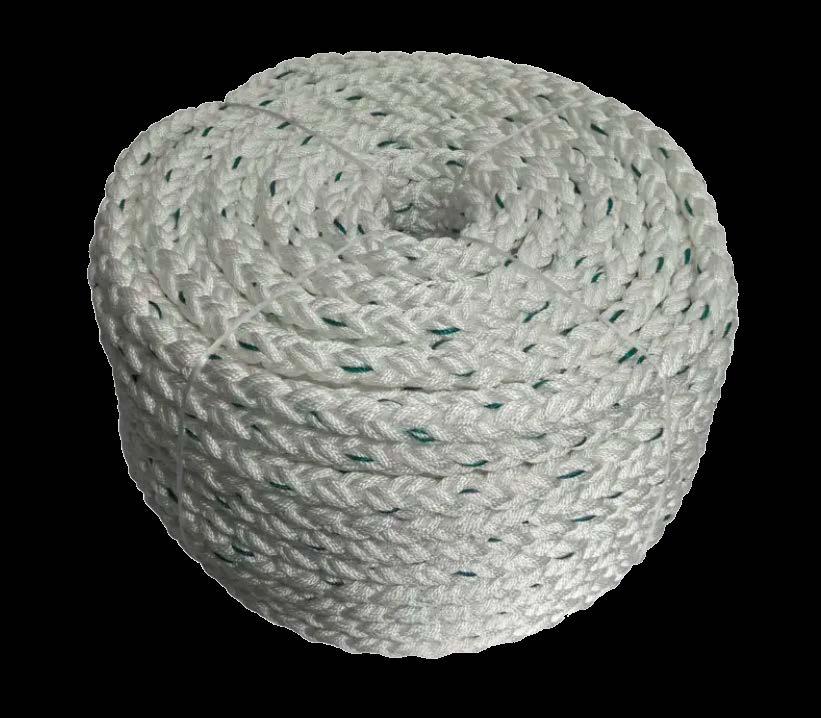
Wayne Holdt is Yachting NZ’s regional development manager for the central region, a former national Noelex 22 and 25 champion, and an experienced cruising trailer yachtie.

Hartley 16 associationclass of NZ
Category: Trailer yacht
Established: 1965
Annual membership fee: $20.00
2025 national champs: Russel Durrant and Clynton Leuty (Bizzare)
Next event: North Island championships (Lake Ngaroto, November 8-9)
President: Jason Holdt
Phone: 027 432 8899
Email: jasonholdt@gmail.com Website Facebook
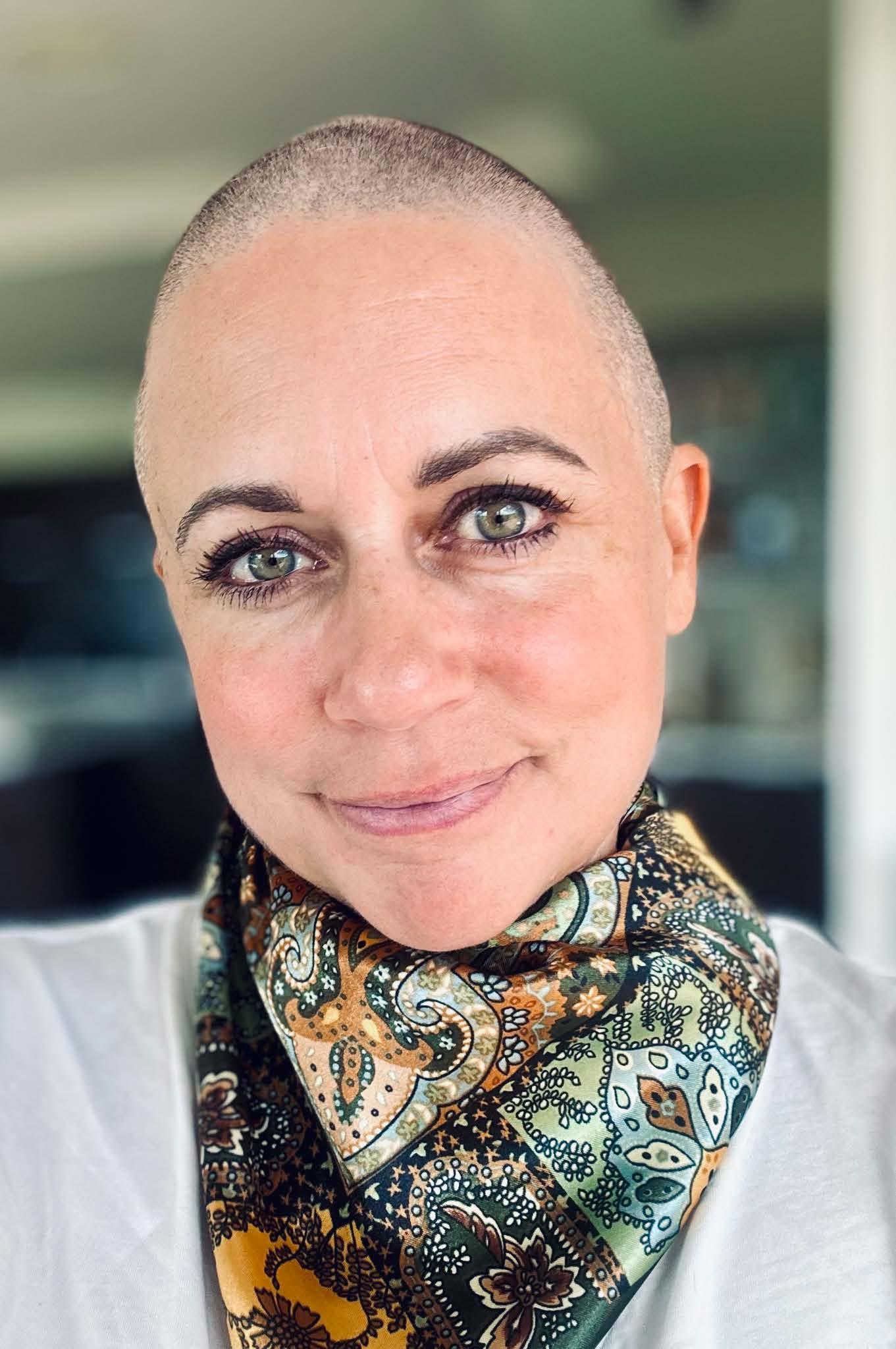
‘I DIDN’T WANT EVERYONE WORRYING I WAS GOING

room, she’s stayed connected to the nearly 200 boats on this year’s Rally. But she’s missed being there in person - welcoming sailors as they make landfall on the islands of the southwest Pacific.
“It’s been great to live vicariously through their experiences, looking at their photos and feeling like I am along for the ride. I think I would have lost the will to live if I’d been laying on the couch just watching Netflix,” Moore, about to turn 50, says.
In May, Moore underwent her sixth - and hopefully final - round of chemotherapy treatment. “Each round gets worse, and it’s taken a wee bit to bounce back from this last


- Island Cruising (which she bought in 2021), the Down Under Rally (the Australian business she took on in 2023) and the Hunting and Fishing store in Christchurch.
Although she didn’t get the “chemo fuzzy brain”, she gratefully accepted help from colleagues and business partners, especially Cecile de Ruijter and Gemma Dooley who kept the Rally on track.
But Moore told very few people she was unwell apart from close friends and family. “For quite some time I didn’t want everyone worrying I was going to die,” said Moore, who has one adult son. “I didn’t want people thinking they couldn’t contact me when they’d paid up to join this amazing Rally; that I wouldn’t be around.”
She was able to continue working from her couch and wear a hat on webinars, after chemo robbed her of her hair. It wasn’t until her scan midway through her treatment, when she knew it was working, that she let others know.
“The support and wonderful comments I got were completely overwhelming and gave me the boost I needed to get through the last three months,” Moore said. “You’re going through this brutal treatment that’s hard to handle, but thankfully my midway scan was extremely positive.”
Moore has also been suffering FOMOwatching boats head off to the Pacific “but not being able to wave them off” or join them in the islands. But the work she’s poured into growing the rally over the last four years has set it up well.
“In terms of timing, it probably came at a good time. Until this point it’s been a real learning curve for me,” she said. “The first year, just post-Covid, was learning what happens when the boats arrive in Fiji; the following year was Tonga and Vanuatu, and then I bought the Australian business.
“Now I know what people are going to




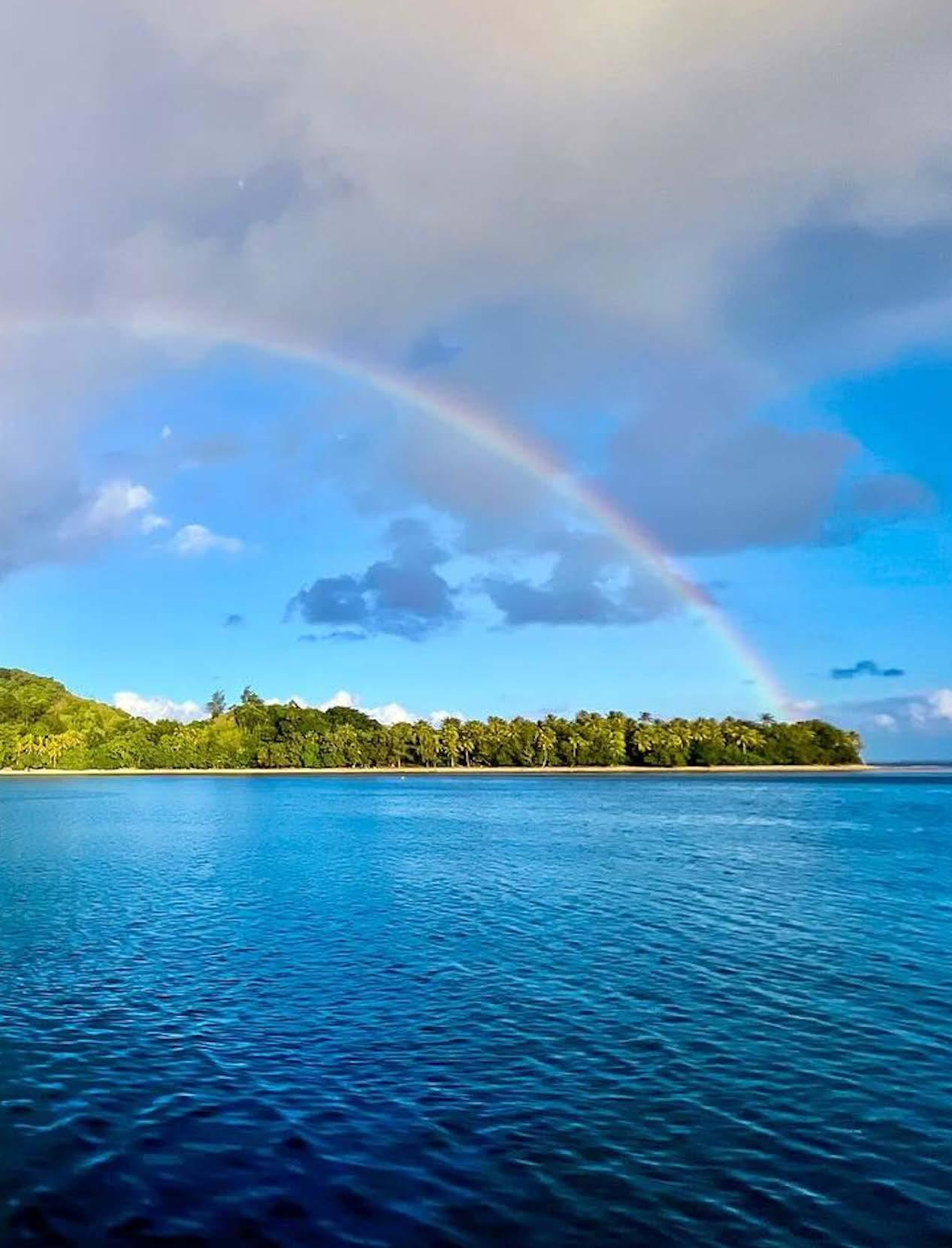
encounter on the rally. And Cecile and Gemma have been amazing - they ran the whole thing, and they did it exceptionally well. But I still missed that connection, meeting the people, which I personally really enjoy.”
Once she’s rebuilt her immunity, Moore plans to return to Fiji, where the United Nations have asked her to speak on maritime crime in the South Pacific. “They think yachties are trafficking drugs through the southwest Pacific, and quite a few boats on last year’s Rally were searched in Fiji - some of the crews didn’t have a great experience,” Moore said.


‘The support and wonderful comments I got were completely overwhelming and gave me the boost I needed to get through the last three months’
Viki Moore
“I reached out to them and said, ‘We’ve got eyes all over the Pacific - we could be a really good ally for you to suspicious stuff’. So, we’re helping them now.”
Moore is also stepping up to protect the interests of cruisers arriving in New Zealand.
“New Zealand Customs is proposing changes for international cruisers visiting New Zealand, so we’re doing a lot of advocacy work and pushing back on some of their ideas. I quite like a bit of lobbying,” said Moore, who worked in Parliament as executive assistant to Speaker of the House, Sir David Carter, and as the liaison between the National Party and the South Island electorates.
Moore has recently been reunited with Bella Vita in Auckland - friends have helped keep the yacht ship-shape.
“You really appreciate help at times like this, and it’s been lovely accepting kind offers of support,” she said.
And she has a message shaped by her latest experience. “For everyone out there who is feeling healthy - now is the time to get out there and make the most of it! You just never know when the rug is going to get pulled out from under you. It certainly changes your outlook on life.”


Peter Bourke talks with Kathy Young of his adventures circumnavigating New Zealand in his prized half-tonner Diablo.
At 73, most people are content to watch sailing adventures from the comfort of their armchair. Not Peter Bourke. This past summer, the Kawau Bay sailor completed a solo circumnavigation of New Zealand in his lovingly restored 1970 Sparkman and Stephen’s 29ft Diablo. It’s a journey that took him 58 days and covered 2,800 nautical miles (5,000 km).
The story begins in 1970, when a young Bourke first spotted Diablo at the start line of the Balokovic Cup race - a 100-mile race around the Hauraki Gulf.
“She caught my eye, and I thought she was the nicest-looking boat in the class,” Bourke said. “The gun went, and that was the last we saw of her - she’d gone.”
That moment left a defining impression on
the teenager aboard his family’s Cavalier 32. Fast-forward 50 years to 2020, and there was Diablo again - this time listed on TradeMe, looking somewhat worse for wear.
Bourke, freshly retired at 68 and seeking a project, couldn’t resist.
“She looked good in the photos, but up close, she was in a very bad state of repair. But I bought her anyway. I was led by my heart rather than my head!”
What followed was a comprehensive fiveyear restoration that would transform Diablo back into the capable offshore yacht she was designed to be.
Bourke’s maritime pedigree runs deep - his family’s involvement in New Zealand’s maritime history stretches back to the 1800s, when his great-grandparents owned scows that traded around the New Zealand coast.
Today, the family operates Hauraki Express, a marine business based in Auckland.
“I’ve been around boats all my life,” Bourke said.
The work on Diablo was methodical and thorough: new motor, sails, rigging, tanks, stove, wiring, electronics and deck hardware.
“All of the woodwork, painting, sanding, and cursing and swearing was by me,” Bourke said.
But he had a bigger goal in mind.
“The work seemed endless, so I decided to set a goal that would mark the completion of the project.”
‘I didn’t intend it to be solo, but soon found it was much easier just planning for myself rather than a group of people.’
Peter Bourke
Initially interested in the Trans-Tasman single-handed race, timing didn’t align. Instead, inspiration came from elsewhere: “I’ve always been interested in yachts and yachtspeople who sail around Great Britain. I saw circumnavigating New Zealand as an equally epic journey.
“I didn’t intend it to be solo, but soon found it was much easier just planning for myself rather than a group of people.”

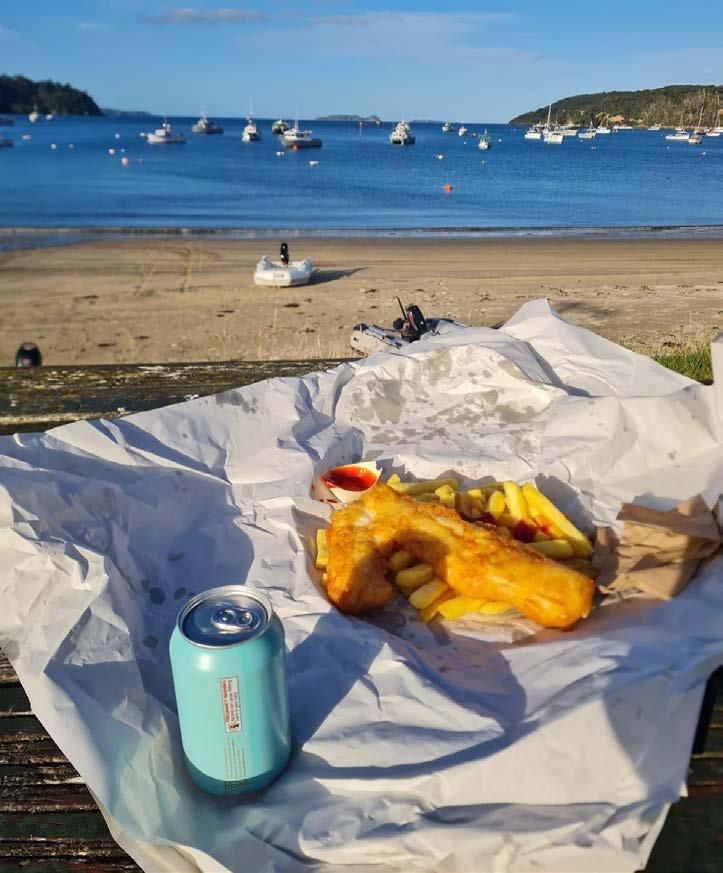


Continued from p67
On January 23, Bourke departed Sandspit Yacht Club for what would become an epic figure-of-eight journey around both islands.
The route choice was deliberate.
“The figure of eight keeps you near the coast. It’s a lot more interesting,” Bourke explained.
There were several challenges, though, particularly across the bottom of the South Island.
For Bourke, one of the journey’s greatest rewards was the marine life.
“I have a long and deep liking of the marine environment, especially seabirds,” he said. “The seabirds of New Zealand are magnificent by world standards. The further south I went, the greater the magnitude of bird life.”
One encounter stands out. About 100 km off Westland, Bourke witnessed an area alive with whales, dolphins and seals rounding up schools of bait fish.
“There were just thousands and thousands of birds on the surface, and the sky was full of albatross, mollymawks and Westland petrels.
“I noticed an orca was in Diablo’s wake, and it swam under us. It stayed there for what seemed like minutes. Diablo was being pushed by the turbulence of its swimming action. I just felt so in touch with the marine environment like I’ve never felt before.”
As Bourke headed south, conditions became increasingly challenging.
The most challenging moment came at Puysegur Point, the remote southwestern tip of Fiordland. Caught in gale conditions around midnight, Diablo’s electronic autopilot failed, causing the boat to crash-jibe and break the main boom.
“It took most of the rest of the night for me to get everything sorted... It was a cold, wet, hungry sail until dawn.”
How he handled the crisis came as a surprise to Bourke.
“I stuck my head out of the cabin, and saw it was broken, and I didn’t panic. I just said to myself, ‘Well, you’ve got a problem to fix. Get on with it’.”
Assistance came through classic Kiwi ingenuity and community spirit - Bourke sailed into Milford Sound, where a fisherman transported the broken boom to an engineering company in Te Anau. They built


a replacement boom, had it trucked back, and Peter lost only half a day.
Another severe test came at Farewell Spit, where 50-knot winds and steep seas pushed up by Cook Strait currents created extreme conditions. “I was doing 12 knots surfing down these waves with no sail set,” he said. “The good thing was I was going so fast that soon I got to shelter at Farewell Spit.”
Bourke’s recommendations to others considering a similar adventure include knowing your boat, proper safety equipment, and perhaps surprisingly, being less conservative with weather windows.
“On reflection, I was probably too conservative in choosing weather windows. Often, I’d be wishing for more wind,” he said.
He preferred staying offshore rather than coastal hopping: “I guess I enjoyed the marine environment more than places on the coast. I can visit those by car.”

Safety remained paramount throughout.
“I never went outside the cockpit without my harness on, clipped onto the jackstay. I was fortunate to get advice from meteorologist Bob McDavit (‘MetBob’) on top of reports from PredictWind and MetService.”
Bourke doesn’t plan on slowing down.
His wish list includes the 2026 Solo TransTasman race, where Diablo “will most likely be the oldest, smallest and slowest yacht in the race”.
Afterwards, he’ll leave Diablo in Brisbane over winter, before cruising down the Australian coast to reach Hobart for the Australian Wooden Boat Show in February 2027.
“Upon reflection, I’m convinced the circumnavigation of New Zealand is one of the great sailing adventures in the world.
“Not in terms of extreme, but in terms of variety, destinations along the way, wild remoteness, marine life and the challenge.”

Kathy Young investigates how big the impact could be from changes to small craft import rules.
For the first time in 15 years, New Zealand Customs Services’ processes for yacht imports are under review. This could lead to changes, as Customs seeks to ensure small craft entering New Zealand waters comply with legislation.
All imported goods, including yachts, are subject to duties and GST as a debt owed to the Crown under the Customs and
Customs permits vessels to be temporarily imported via a Temporary Import Entry (TIE) when overseas-based yacht owners are visiting New Zealand for holidays or repairs. Importers can do this without paying duty or GST, provided a security is given - usually in the form of a written undertaking.
Under the previous system, Customs had allowed vessels that had been temporarily imported to be sold to nonresidents without paying duty or GST. This practice has now ceased, with Customs acknowledging it was not compliant with the Customs and Excise Act 2018
The new approach is similar but introduces greater protections around Crown revenue before a sale. Conditions for the sale of temporarily imported small craft now include: the vessel must
only be offered for sale on the foreign market, the buyer must be a non-resident, and sufficient security must be in place. Customs may also require more tangible security - such as a monetary depositinstead of a written undertaking.
However, Customs has indicated that each sale application will be assessed on a case-by-case basis.
According to Max Broadfoot, Manager of Revenue and Service Delivery at Customs, officials are “working through all the different guidance” and will publish clarity for the industry soon.
The changes were introduced following an internal review conducted by Customs in March. Broadfoot explains


Brokers believe the changes could threaten many in the industry - including sailmakers.

that the organisation brought together experts to examine how the small craft arrivals process was functioning.
“Coming out of the Covid years, and with the new Act passed in 2018, we hadn’t done a thorough review of how the arrivals process for small craft was working since that time,” he said.
During this review, Customs identified that it had not been applying the legislation correctly in cases where small craft arrived temporarily and were later offered for sale.
This discovery required immediate action, Broadfoot said.
“Because of the level of noncompliance and the way we were doing things, it wasn’t possible to continue with the current practice, and it wasn’t possible to take the time to go out to industry. We had to correct course immediately.”
Yacht brokers who had been facilitating tax-free sales of foreign yachts to overseas buyers have suddenly found themselves facing major tax bills.
Auckland yacht broker Robbs Hielkema, from 36 Degrees Brokers, has experienced this firsthand.
“Someone came to view a boat. They made an offer; the vendor accepted it. We let Customs know as we usually do, and the response from Customs was that the vendor had a bill to pay of $100,000,”
Hielkema said. “It was quite unnerving. Customs seems to have opened up some legal issues here.”

Hielkema fears the change could have far-reaching effects on the New Zealand industry, due to the convoy nature of cruising yachts.
“When one yachtie comes, 20 of his friends come, too. They typically have damage and things to fix on their yachts and call on the services of many marinerelated businesses when they arrive in New Zealand.”
Hielkema believes yacht owners may now choose not to come to New Zealand to sell their boats and the ripple effects could threaten sailmakers, riggers, plumbers, electricians, chandlery companies, delivery skippers, marina operators, and even dockside cafés and shops - especially in Northland, where many international yachts first make landfall.
According to Customs, around 500 vessels arrive in New Zealand waters each year. In the past two years, 52 of those sought permission to sell, and 13 completed sales.
“We think it’s only around 6 per cent per year of arriving small craft that are going to be directly affected by this change,” Broadfoot said, adding that the changes don’t prevent vessels from coming to New Zealand or accessing marine industry services.

Customs acknowledges the impact but insists the changes were essential.
“We fully accept this is going to have caused shock and frustration to the industry, but we’ve been trying really hard to explain that we’re not doing this because we want to do it. It’s because we have to do it under our legal framework,” Broadfoot said.
The new system brings New Zealand into line with international practiceincluding Australia and Fiji - where a similar approach is taken. According to Broadfoot, New Zealand had previously been “more competitive” because “we have been doing things the wrong way, and people have been able to take advantage of that”.
Beyond yacht sales, Customs has completed its consultation on broader small craft import regulations, though conclusions are yet to be reported.
The review examined several key areas that could affect how international vessels visit New Zealand:
• Reduced-stay periods: Customs is considering reducing the current 24-month TIE to 18 months. Most small craft arrive between October and December. The 24-month period was



complete the required paperwork. The new system would retain this zero-rating capability but improve compliance.
• Restrictions on re-entry: Customs would generally not approve a second TIE for craft that have stayed the full term, briefly exited the 12-nautical-mile limit (international waters), and returned immediately.
• Resident requirements: New Zealand residents bringing vessels back may face stricter rules. If a craft leaves only for the off-season, permanent importation - with full duty and GST - would be required on its second return.
The marine industry has not accepted the changes quietly. Northland MP
Zealand Customs, and remain confident that common sense will ultimately prevail, even if legislative changes are required to safeguard the export-driven market of large-scale yacht refits that quite literally float our shores,” Busfield said.
Viki Moore, Director of Island Cruising NZ, also expressed concern at Customs’ mid-season changes.
“The industry is disappointed that we weren’t consulted prior to them making the changes around the sale of TIE vessels,” Moore said.
She argues the previous system was working well and highlights the need for more practical engagement and said Customs would be wise to “sanity check their decisions with the industry before taking action”.
“It’s really important that they make
a decision, and they make it quickly and clearly, so that people planning to visit New Zealand this season can make informed decisions about their routes.”
According to Hielkema, YouTube cruising channels are already documenting departures, with some describing themselves as “escaping New Zealand” and choosing Australia as a destination to sell, due to Customs’ pursuit of tax payments.
“It may sound like a bunch of rich guys whinging about having to pay tax,” he said. “But it’s more than that because it’s about getting people to come to New Zealand. People need a reason to come here from so far away.”
Industry stakeholders now await further information from Customs, following the close of consultation on July 1 for the broader review. Customs has confirmed it expects to implement changes in March 2026, ahead of the 2026-27 arrivals season.
Customs says it will issue guidance on the sale of small craft under TIE in the coming weeks.
In the meantime, yacht brokers like Hielkema believe the uncertainty is already denting business confidence.
International buyers are hesitating, vessel owners are changing plans, and the network of marine businesses that rely on visiting yachts is preparing for disruption, he said.
Funding is the lifeblood of every yacht club. This comprehensive guide shows how to secure the support needed to keep yours thriving.
Funding is essential to the survival and growth of clubs. It provides additional funds over other income such as memberships and is often the main source of income for many clubs.
There is often money available through various agencies but remember - other clubs and groups also compete for it so it’s worth putting in the effort to do it well.
Yachting New Zealand's partnership and events coordinator, says it's a good idea for clubs to consider appointing a dedicated fundraising person or to establish a fundraising committee.

"Their role would be to decide which of the club's projects or activities require additional funding, and to develop a fundraising plan and identify potential sources of funds," Jordan said.
"They would also write the grant application or sponsorship proposal, ensure the funds raised are used for the designated purpose and maintain relationships with donors, grant agencies and sponsors."
There are several different funding streams available to clubs with grants, sponsorships, and fundraising the most used.

grants.
There are many different funding organisations that provide grants to community and not-for-profit organisations, Jordan said. Funding available to community organisations in New Zealand generally comes from eight main sources - community trusts, energy trusts, government and council funds, community foundations, gaming trusts, family and individual trusts and foundations, licensing trusts, and corporate foundations.
Each of these sources and the individual funds within them has its own criteria, priorities, and processes for giving grants, reflecting the diverse needs and goals they support.
"Planning goes a long way and it is important to look at which funders might support your club and project," Jordan said.
"Most funders have information on their website that includes information on the sorts of work and organisations they want to fund. Doing basic research into funders can save you time and energy in the long run."
A desktop research process can help your club find information on funders that may grant funds towards your club projects. There are also websites that you can pay for help to search for all available sources of funding. Two of these are:
This is a paid subscription service, but it offers free access via public libraries outside Auckland. Generosity NZ provides comprehensive information on scholarships, grants, and funding opportunities for individuals and community groups. It is a valuable resource for finding funding that matches your specific needs.
A paid subscription service provided by Strategic Grants, GEMS offers a sophisticated database and management system that helps organisations identify suitable grants, track applications, and manage reporting.
There are eight different types of funders in New Zealand, according to Jordan:
Community foundations
There are 17 across New Zealand, with each serving specific regions. They raise money to give to their communities and donations are placed into endowment funds, where they are invested and income generated is used to fund community causes. Community foundations of Aotearoa New Zealand have more information about the foundations around the country.
Community trusts
Created using money from the sale of government assets, they manage large investments for their communities and use returns to fund grants in specific priority areas. There are 12 independent regional community trusts - including Community Trust South, and Foundation North
Corporate foundations
Set up by businesses to manage their charity work and community investments, these foundations are a part of the company's broader plan to act responsibly and align with its values and goals. Examples include ANZ Staff Foundation, Harcourts Foundation, Spark Foundation etc.
Energy trusts
The aim of energy trusts is to manage assets of community-owned energy companies after local energy supply authorities were privatised. Grants are usually funded by profits from the electricity distribution companies the trusts own - like Central Lakes Trust, and WEL Energy Trust
Family and individual trusts and foundations
Established by wealthy individuals and families to support various social causes and community initiatives. These include the likes of the Tindall Foundation, Wright Family Foundation and others.
Gaming trusts
Gaming trusts allocate proceeds from gaming machines in pubs and clubs to various community, charitable and
sporting groups. Funds are distributed in the areas that gaming venues are. There are around 30 major gaming trusts operating in New Zealand. These include The Lion Foundation, New Zealand Community Trust, and Aotearoa Gaming Trust. A full list of gaming trusts can be found here and a regional breakdown here
Government and council funds
These funds are created and managed by government agencies, or appointed trustees, or regional or district councils to support public and community initiatives.Examples of councils include Auckland Council, and Christchurch City Council. National communityfocussed fund examples are Lotteries Community Funding, and Sport New Zealand (below), who partners with 14 regional sports trusts (RSTs) to manage and distribute funds - such as Tū Manawa Active Aotearoa.
Licencing trusts
• Detail the methods used to conduct the project.
• Indicate the expected outcomes of the project.
• Consult advisory officers.
• Submit applications before closing date. Also remember…
• Create a funding plan: Funders want to know your project is going ahead and how you plan to raise additional funds (if necessary). Create a funding plan which outlines how you plan to raise the funds and where, when and how their contribution will be spent.
• Big projects: If you have a big project, it may be better to split the project into several small increments and apply to different small trusts for each increment. Do not apply to more than one trust at a time for any increment or project as the trusts communicate and will reject you.
• Follow up: One very important factor that clubs often forget is to follow up with the trusts - don't take the money and run! Once you have either finished a project, make sure that the club writes to the trust thanking them for their support and send them pictures of what they helped fund. This will help hugely when approaching the same trust for further support - especially for major projects.

Operate in different regions and have exclusive rights to sell alcohol in specific areas. They were created to ensure profits from alcohol sales benefit local residents by reinvesting profits back into community projects and services. Invercargill Licencing Trust, and The Trusts are two examples.
Clubs that are successful in attracting grants usually:
• Prepare a yearly calendar of closing dates for all funding sources.
• Request application forms well before the closing date.
• Prepare the application in advance.
• Pay careful attention to the details required and the presentation of the application.
• Clearly outline the goals and objectives of the project.
• Describe why the project is needed and support this with facts and figures.
• Regular contact: Remember to keep in regular contact with your local council. Meet with them once a year to present how the club is going and what plans are in place. Do this even if you are not approaching them for money. They will appreciate that you are keeping them up to date with the club activities and that you are doing this without the tie of requesting funding (at that point). Building this relationship will help when you do approach them for funding.
• Affiliation: Being an affiliated yacht club or member with Yachting New Zealand helps clubs and associations with their application. Yachting New Zealand is happy to provide letters of support for club funding applications and certificates of affiliation. For these contact your regional development manager.
• Ask: If you don't get the funding you applied for, it's a good idea to ask the funders why - they are often happy to discuss this if it is an application issue. Continued on p76

According to Samantha Alexander, the Lion Foundation's national compliance and grants manager, the most common mistakes applicants make, include:
Applicants submit a resolution that authorises applying to a different trust; the purpose of the application doesn't match the actual proposal in the paperwork; or the amount in the resolution doesn't correspond to the amount in the paperwork.
Avoid an information dump which advisors must spend a lot of time sorting through. Try to align previous successful grants with your current application.
The main contact and second contact cannot receive a benefit from the grant (as per DIA guidelines). Examples include for contracted wages, salaries, own supply shop etc.

• Just because you don't want to find a competitive quote doesn't mean that we will accept this argument: "We have a sponsorship arrangement - thus must use the supplier per the sponsorship agreement".
• Competitive quotes that don't compare apples with apples.
• An internal budget is not a quote or cost evidence.
Applying isn't the same as receiving funding - wait to hear back before purchasing. Also, check what you can spend money on: the authorised purpose is listed in your grant approval email. Don’t add any items not listed.
Only one successful application per 12-month period is allowed. The date that funding has been received should be your guideline.
Sponsorships provide funding, resources or services to your club in return for association with the
or for certain

Sponsorship is when businesses and companies provide funds, resources or services to a club in return for rights and/ or associations with the club.
These rights or associations help the business commercially. This may take the form of a logo on clothing, signs at the club, or free advertising in a newsletter.
According to Jordan, sponsorship links a club with a sponsor in a mutually beneficial relationship and it is not just about money.
"A good sponsor can add considerable value by, for example, becoming the club's primary promoter. In the longer term, this may be of more value than the sponsorship income initially received," she said.
• Club members, family and friends: Before looking elsewhere, ask club members, family and friends if they have any contacts with potential sponsors.
• Local businesses and suppliers: Research local businesses and target those who could benefit from a partnership

with your club.
• Larger organisations: Larger organisations have more resources available but are often inundated with requests. They can be harder to connect with unless you have a contact.
Before starting your proposal, your club needs to identify the type of support your club needs (e.g., cash or in-kind services), businesses that could provide appropriate support, and what types of benefits your club can provide the sponsor.
Some examples of typical contents for sponsorship proposals include:
• A cover letter: Address the proposal to the most appropriate person in the sponsor's organisation.
• Overview: Provide an outline of the project and/or the club. What are you asking sponsorship for? What and where does it happen? Relevant statistical information in sponsorship proposals can help the assessor get a picture of the club or event and identify cost
benefits. Market demographics define your membership, public and audience. Identify niche markets the club can deliver to, as this makes it easy to be matched to a particular audience.
• Objectives: Outline the objectives of the project and/or the club.
• The investment: Outline the funding amount or in-kind support being sought. What is it going to cost the sponsor and what is the period of the agreement?
• Sponsorship benefits: This is a critical component. Look to include benefits such as naming rights, promotion strategies, signage, media, brand awareness opportunities, and articles in newsletters or websites etc. For most companies, media exposure is an important part of sponsorship. Wherever possible outline how you can get radio, TV, newspaper and social media coverage, as well as community access in the proposal.
• Target market: Outline who the project is aimed at or provide a membership profile. Identify how it matches the target market of the proposed sponsor or how it
could benefit them. A successful outcome is more likely if you tailor the proposal to a specific sponsor.
• Exclusivity: Detail other sponsors and/or supporters of the project or the club. Make sure sponsors are not in competition with each other.
• Servicing the sponsor's needs: Outline how you will cater to their needs. Identify a designated employee or volunteer to be the contact for the sponsor.
• Evaluation strategy: Outline how you plan to evaluate and measure the success of the agreement.
• Conclusion: Summarise the proposal, identify a follow-up procedure, and supply contact details.
"Finally, don't do it at the last minute," Jordan said. "Give the club and your potential sponsor plenty of time. The assessment, negotiation and planning involved in managing a sponsorship can take a while. Allow plenty of lead-in and planning time."
Continued on p78
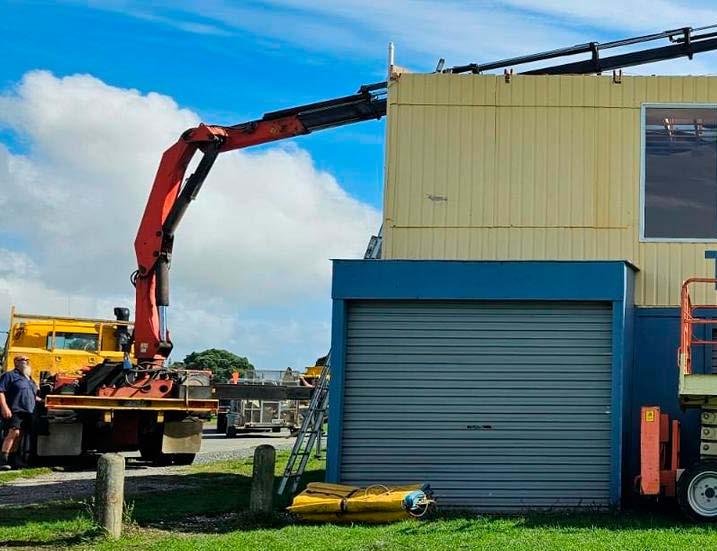
Fundraising is a cost-effective way to make money for your club. Your greatest supporters are your members, their families, friends and the local community.
"Fundraising can be hard work and involves a lot of planning and resources. It's a good idea to gather committed volunteers who will support the project through to the end," Jordan said.
"It shouldn't be considered to pay for the everyday operational costs of the club. Rather, it should fund special activities such as new buildings, special events, overseas team trips, and new programmes or projects."
There are plenty of websites with great fundraising ideas - and Givealittle is an increasingly popular platform of crowdfunding, as Taipa Sailing Club recently discovered.
• The 80/20 rule applies to fundraising. Eighty per cent of your income usually comes from 20 per cent of your supporters. Identify who your supporters are and develop a long-term relationship with them.
• People give to people, so ensure your potential donors know the faces behind the names, understand your cause, and can relate to the purpose of your project.
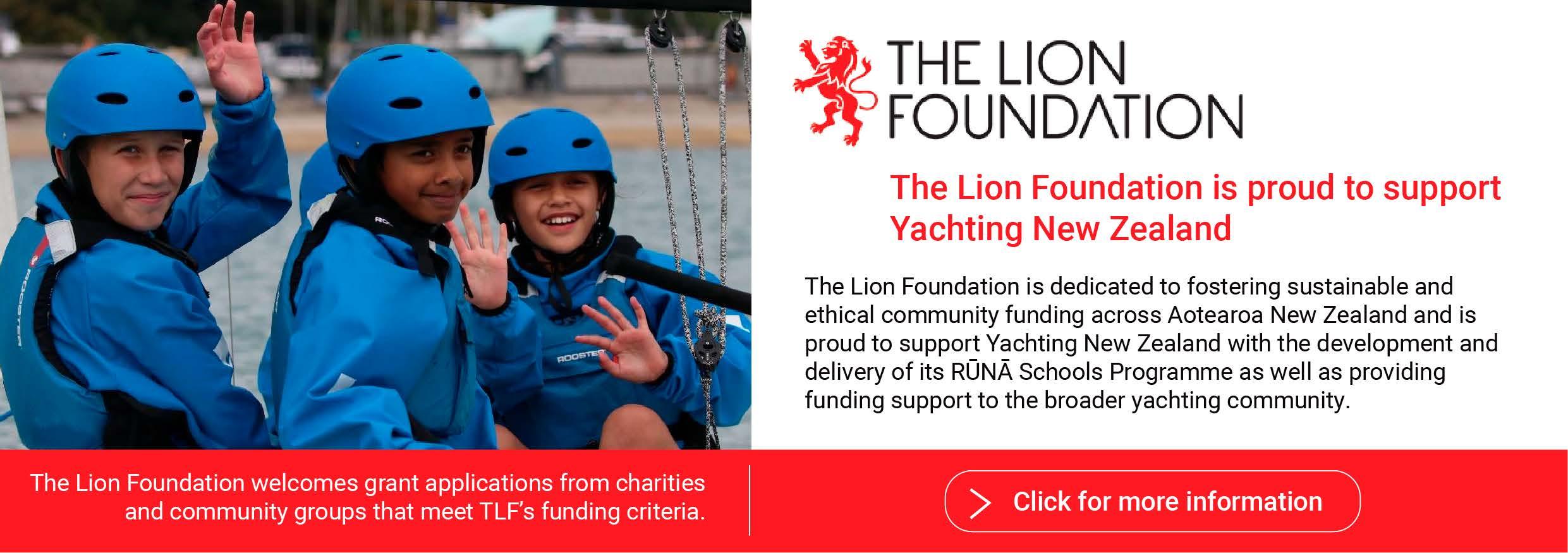
Taipa Sailing Club recently raised over $12,000 through Givealittle, following severe storm damage to their building.

Can you identify some patrons who would be prepared to become the public face of your project? Patrons may be high-profile and respected sports people, businesspeople or other community figures.
• Always say "thank you". Acknowledge donors in numerous ways such as honour boards, annual reports, certificates of appreciation, phone calls and letters from your members.
• Always let people know how much you would like them to give. It makes them feel comfortable and makes you look competent.
• Explain what the donor will receive for their donation, for example, a tax deduction and knowing that they are helping the local community.
• Until you try something, you won't know whether it will work. Be prepared to test an idea on a small scale and assess its

success before going to a lot of expense.
• Try something different. All products go through cycles. Fundraising activities need modifying from time to time. Your idea may be good but look at how you can make simple changes.
• Do not confuse the donor - keep everything simple, clear and easy to understand.
• Always tell the truth. Don't be tempted to make your case stronger than it is.
NZCT is one of the largest gaming societies in New Zealand and the country’s biggest funder of amateur sport. We believe that New Zealand’s communities are at their strongest when people actively come together – to take part, organise or be a vocal supporter.
NZCT is committed to helping people achieve their best, and by supporting sports competitions, we hope Kiwis are inspired to work hard, reach for their goals and excel.
W We have 100 publicans throughout the country raising funds for us by hosting responsible gambling operations We d like to acknowledge the work they do, because without them, we couldn’t continue to fund great sports like yachting
Sacha McGregor will soon become the first female commodore in the history of New Plymouth Yacht Club. But, as Kathy Young discovers, breaking moulds is nothing new for this former foundry owner.
Sacha McGregor doesn’t hesitate when asked about becoming one of only six female commodores among New Zealand’s 106 affiliated yacht clubs.
“Any opportunity to break a mould!” Having grown up at New Plymouth Yacht Club, where her father Alan sailed, McGregor went through the learn-to-sail programme as a child, though she admits she “wasn’t very good at sailing”.
Her path to the commodore’s role - she will become the first female to lead the club in its 86-year history later this month - began instead through her children, particularly due to one of her sons’ health

conditions.
“When our youngest, Ethan, started sailing, I needed a reason to be chosen to be put on the water in case I needed to support him with his type 1 diabetes,” she explained. “So, I started getting on the start boat. That’s how the race management interest started, as well.”
Her journey has since evolved into an impressive race management career. McGregor recently completed the training required to become an international race officer, and recognises she has a natural talent for the high-pressure, multi-tasking demands of the role.
“I enjoy race management. I like the

fun you feel when it’s over and when you recognise what you’ve accomplished,” she said. “You’ve got a lot to juggle. You’re looking at safety first, as well as the course, weather and timing.”
McGregor progressed through the Optimist circuit with her children, attending the Australian Optimist national championships in 2020 and, more recently, travelling to the CORK Regatta in Kingston, Canada - a multimonth event featuring various classes across several days. There, she successfully completed an assessment that earned her a key reference towards international race officer status.
With her national race officer qualification secured in 2023, McGregor is now working to accumulate further international references as she aims for full international certification.
“I’m hoping to be able to get to the Olympics in 2028,” she said. “That’s the goal.”
Wayne Holdt, Yachting New Zealand’s regional development manager for the central North Island and a long-time acquaintance of McGregor’s family, isn’t surprised by her rapid rise.
“She’s very organised, really easy to

get on with and has heaps of energy and drive,” Holdt said.
That energy has been evident in McGregor’s initiatives during her three years as vice-commodore at the club. She has helped transform the adult learn-tosail programme from short, one-on-one sessions into a season-long commitment that fosters lasting engagement. The club’s women-on-water programme has also flourished under her guidance, with an emphasis on camaraderie and participation.
“When you don’t put a man on the boat, they don’t take over,” she laughed. The approach has proven effective - the
‘Women make fantastic race officials because we’re organised and we can think about multiple things at once. I think the same goes for the commodore role: we’re level-headed, generally, and we can listen to 15 sides of an argument and work it through!’
Sacha McGregor
club’s adult programme is now 80 per cent female. Perhaps uniquely among commodores, McGregor brings extensive race management experience to the role.
“I think I might be the second in our club who’s been a national race officer as well as commodore,” she said.
Her advice to other women considering similar roles is direct and encouraging: “Own the space, be excited, stand up and speak. I think you’ll be pleasantly surprised at the responses you get.”
With major events, including the Optimist nationals, coming to New Plymouth this season, McGregor will soon have the opportunity to showcase both her organisational skills and the club’s sailing waters to the wider community.
“Being able to say ‘yes’ to events like these has been fantastic, and it’s all thanks to our fantastic group of volunteers.”
She believes her race management skills translate seamlessly to leadership.
“Women make fantastic race officials because we’re organised and we can think about multiple things at once. I think the same goes for the commodore role: we’re level-headed, generally, and we can listen to 15 sides of an argument and work it through!”

Established: 1939
Location: Ngamotu Beach, New Plymouth
Commodore: Scott Hodges
Membership: 200
Notable current/former members: Craig Monk, Ross Field, Sam Street, Jamie Sutherland.
Fleet(s): Optimist, Starling, 420, ILCA 6, ILCA 7, Paper Tiger, Hartley 16, Noelex 22.
Known for: Running the Solo TransTasman Yacht Challenge - the second oldest continuously run single-handed ocean race in the world.


Recent workshop showed just how much sailing and basketball have in common.
At first glance, it’s hard to imagine two sports more different than yachting and basketball. But when coaches and officials from both came together at Ponsonby Cruising Club for a recent facilitation workshop, the similarities quickly surfaced.
The one-day session in June brought together 12 participants from across codes, all connected by a common purpose: learning how to run better, more impactful training and development courses in their respective sports. What followed was a day of surprising parallels, shared insights, and practical takeaways that transcended disciplines.
The workshop was led by a team of three facilitators - Simone Spencer, sport development lead at Aktive; Basketball New Zealand people development lead Tracy Wrigley, and me. The group of attendees was made up of four yachting race officials, three yachting coach developers, two Yachting New Zealand staff, two basketball referee facilitators, and one individual expected to deliver coastal personal safety courses in partnership with Yachting New Zealand.
Rather than focusing
on sport-specific content, the session was designed to explore what makes facilitation effective, regardless of the context. By removing technical detail, the workshop created space to focus on universal principles: creating safe and inclusive learning environments, supporting skill development through practice, and communicating in ways that truly connect with learners.
This cross-code approach allowed participants to step outside their usual frameworks and consider new perspectives. It also encouraged conversations about how similar challenges are tackled in different environments - whether that’s brainstorming


with sailing coach developers or preparing referees for a fastpaced basketball season.
The format struck a balance between theory, discussion and application. Group activities and structured reflection encouraged participants to think critically about their own practice while learning from others. There were also moments of light-hearted connection, including a memorable “moo-off” between two race officials during an icebreaker session. Every attendee left with a bank of new activities to use in future sessions - and in many cases, new confidence to lead them.
The day concluded with small group discussions focused on practical application. These final sessions generated several strong ideas, from adapting course content to better suit club-level delivery, to reshaping current programmes to be more participantled. One coach developer who attended is now preparing to deliver a coaching course independently for the first time, and several race
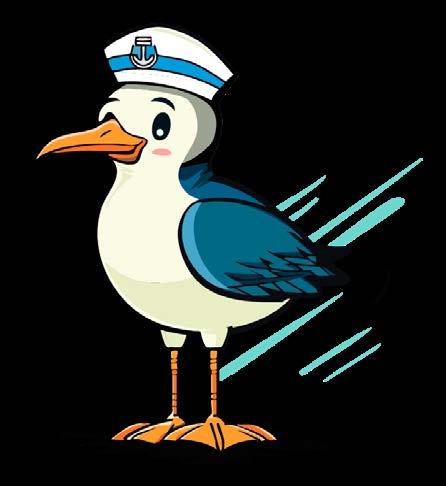

officials are being supported to take on more active roles in running workshops, seminars and courses.
The hope is to build on this momentum and make the workshop an annual fixture - supporting the sustainability of coaching and officiating programmes through continuous learning and developing a stronger network of facilitators across sport.
Events like this show that while sports may differ in environment and equipment, the foundations of great facilitation are universal. Whether guiding coaches through ways of interacting or race officers through course management, the ability to communicate clearly, foster safe spaces, and inspire learning is what ultimately makes the difference.
And when different sporting communities come together to share their knowledge, everyone wins.
Kirsten Moratz has been coaching in New Zealand and internationally for the past 16 years. She has been Yachting NZ’s coach development manager since 2022.
Yachting New Zealand is preparing to release new look Learn to Sail (LTS) booklets ahead of the new season, following an extensive review and redesign process driven by club and coach feedback.
According to Kirsten Moratz, Yachting New Zealand’s coach development manager, a nationwide review of the LTS programme in 2023 revealed that some existing resources, including the long-standing booklet, were no longer meeting the needs of sailors, coaches or clubs.
“Feedback gathered from surveys in 2024 confirmed this, with many describing the booklets as too wordy, overly advanced in parts, and lacking interactive elements,” Moratz said. “We heard from clubs who use the booklet, those who don’t, and those who follow different pathways.”
Common suggestions included better preparation for new sailors before getting on the water, and improved opportunities for kids to engage with the content.
Level 2 booklets were also seen as too
complex for many sailors at that stage, and again too focused on a single boat type, Moratz said.
“Using the feedback, the Yachting New Zealand team drafted a new concept and shared it with regional coach developers. Based on their input, a redesigned booklet was developed in early 2025,” Moratz said.
Among the most notable changes are newly designed characters (above, below and far left) to replace ‘Hot Harry’ and ‘Cool Kathy’. Instead of fixed names, sailors will now be able to customise their own character, choosing a name, personality and avatar to accompany them through the booklet - offering greater personal relevance and inclusivity.
The layout has also been completely overhauled. Diagrams now feature on white backgrounds so that sailors can colour them in, and large images replace dense blocks of text. Key learning points are paired with interactive activities, allowing young sailors to test their knowledge throughout.

Each level of the new booklet will also include one single-handed dinghy and one double-handed dinghy, with the Optimist, O’pen Skiff, RS Feva, and RS Quest all featured to reflect the most used boats in learn to sail programmes across the country.
Another major innovation is the addition of a QR code linking to a dedicated online hub with videos, tutorials, and tools for both parents and sailors. These include instructional clips on tacking, gybing and knot-tying, as well as links to useful resources such as tide charts and weather apps.
“This makes it easy for coaches to keep sailors engaged onshore and gives families a chance to be part of the learning journey at home,” Moratz said.
The Level 1 and Level 2 booklets will be available for purchase in time for the start of the new season in September.
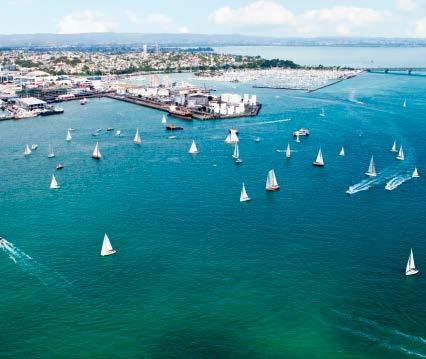
1
Taipa Sailing Club is bouncing back after Cyclone Tam tore off half its roof in April, with over $12,000 raised through community donations to cover repair costs. Despite the damage, sailors were back on the water within weeks, as rebuild plans progress.
2
Sail Northland seeks a centreboard sailing coach for the 2025/26 summer season in Whangārei Heads, offering flexible hours across junior, youth, and adult programmes. Email sailnorthland@gmail.com to apply.

3 In April, Kelsey Muir (left) became the first female helm to win the Lipton Cup in its 104-year history, steering L Class yacht Rangi Manu to victory during the annual regatta at Ponsonby Cruising Club
4 Wakatere Boating Club concluded a successful first RŪNĀ season (right), with over 400 students participating - more than 300 in just four days through Northcote Intermediate’s EOTC week in May. Interest in the programme is growing, with more clubs joining. Click here for more information.
7
The Auckland Yacht and Boating Association (above) has launched a Coastal Plan initiative to protect boating access and infrastructure ahead of next year’s Auckland Unitary Plan review. Boaters can share input by emailing ayba. secretary@gmail.com.
8
The Foil4TheGulf event (right) at Auckland’s Okahu Bay in May attracted over 200 entrants, making it New Zealand’s largest foiling event to date. The event raised awareness for the Hauraki Gulf Marine Protection Bill, with proceeds supporting Live Ocean’s restoration work.

5 Nine RS Quests competed in New Zealand’s first inter-club rally for the class in May, sailing from Takapuna Boating Club (right) to Cheltenham Beach for a barbecue before returning. Plans are underway to make it an annual event.
6
Dr Dave Austin’s offshore medical course (below) returns to Royal Akarana Yacht Club on November 15-16, offering hands-on emergency training for sailors. The $375 course is Yachting New Zealand and World Sailing accredited, with profits donated to charity. Register here

9
Kohimarama


for a yacht club committee boat.
10 A fleet of 63 boats competed in this year’s King’s Birthday Regatta (right) at Port Ohope Yacht Club, the largest turnout in years. Highlights included ILCA titles for Dave Johnson and Miya Prescott, with strong performances across all classes despite challenging winds.
17 18

11
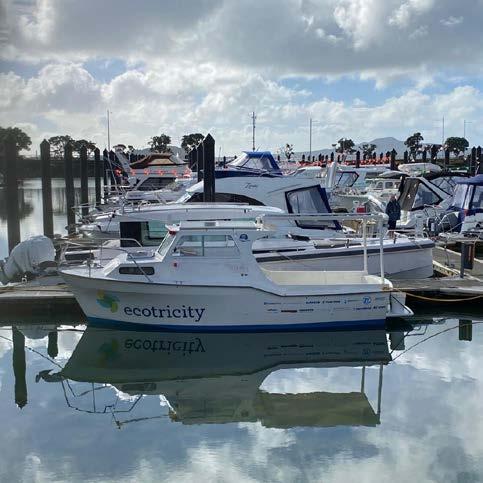
Yacht Club’s iconic committee Marama (right) has returned after a two-year refit, now fully electric and solar-powered. It is believed to be a world-first
Evans Bay Yacht and Motorboat Club will host the 2026 Flying Fifteen NZ nationals alongside the national 420 championships in March, promising an exciting event on Wellington Harbour.
12
Last month, Victoria University students held a weekend exhibition at Worser Bay Boating Club. The group showcased their inspiring visions for the future of Te Motu Kairangi (Miramar Peninsula, right), with organisers saying the exhibition managed to draw strong interest.

13
Queen Charlotte Yacht Club are celebrating a grant from the Lion Foundation that enabled the club to purchase three new Yamaha outboards, with motors being installed thanks to volunteers’ efforts.

14 Waikawa Boating Club (right) won the marine category at the 2025 Marlborough Environment Awards, recognised for its commitment to sustainability in the Marlborough Sounds. Since joining Yachting New Zealand’s Clean Club programme in 2023, the club has introduced solar panels and regular beach clean-ups, among other initiatives.
15 Nelson Yacht Club is conducting a survey to review progress since its 2020 Strategic Review, inviting members to participate for a chance to win club gear or vouchers. here to participate.

at the clubhouse (bottom), with great participation and plenty of laughs.
17

Christchurch Yacht Club received a major upgrade in May when its roof was replaced in a single day as part of a community-driven promotion by The Breeze Canterbury 94.5FM (above). The club won the roofing project through a public vote campaign supporting local organisations making a difference.
Send your club or class association news to eduan@yachtingnz.org.nz

18 Last month, Naval Point Club Lyttelton hosted its annual mid-winter swim, with participants braving cold waters before warming up with hot chocolate and other refreshments from Jet Junkies NZ. The event took place at 10am on the club’s floater, attracting a lively crowd despite chilly conditions (right)
19 After rough seas damaged jetties at Timaru Yacht and Powerboat Club last month, committee members worked hard over the Matariki weekend to make them safe for users (bottom)

16 Port Chalmers Yacht Club biscuit-decorating night

20 Marakura Yacht Club is hosting NZ Coastguard courses throughout winter, with the final Boat Master Course scheduled for July 19-20. Contact info@coastguard.nz for details.
21 Lake Mahinapua Aquatic Club held its AGM and prizegiving in June, celebrating top sailors including Justin Dowell, Nick Palleson, John Kennedy, and Darren Gamble for their season achievements.


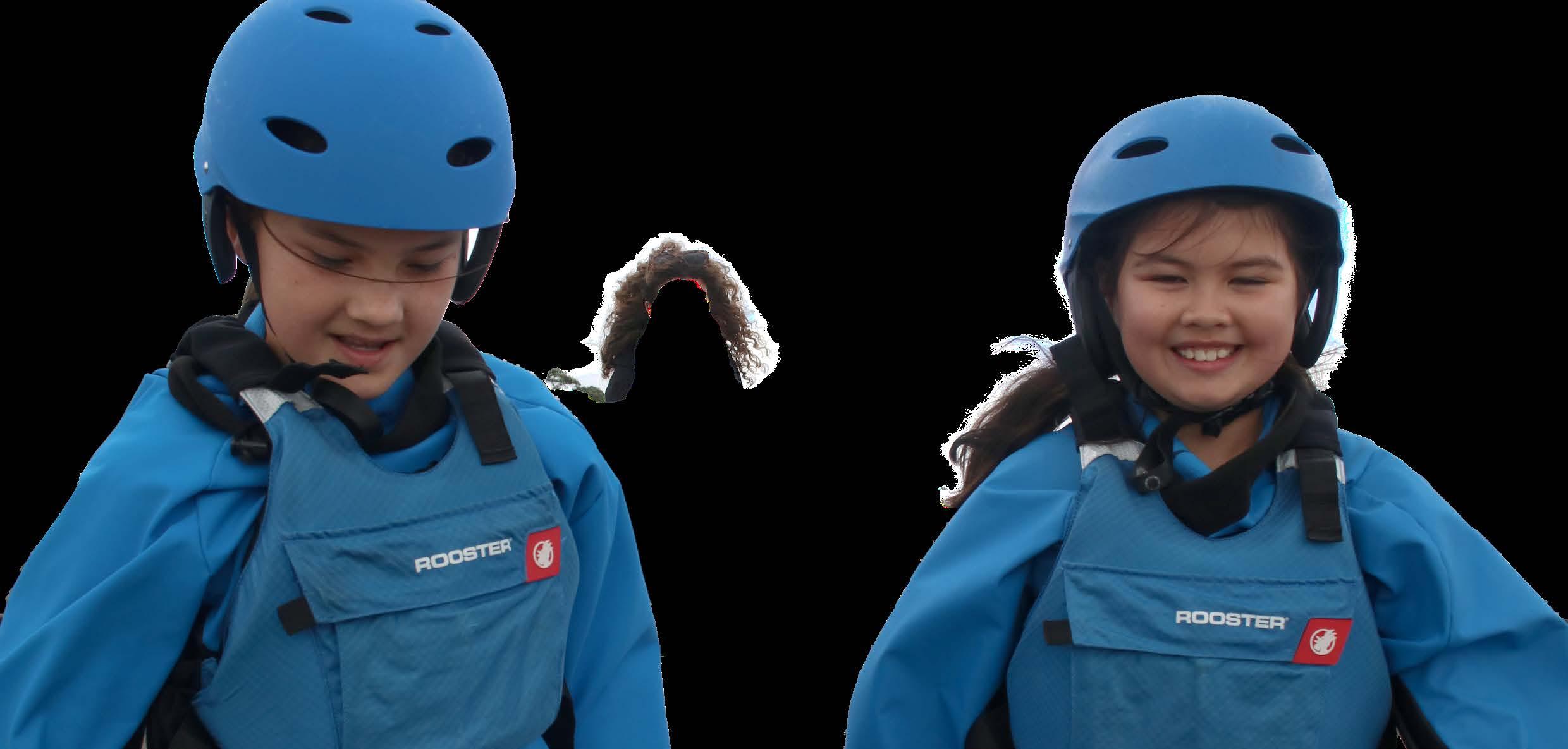
Yachting NZ’s schools education programme hits 7000 for first time.
Yachting New Zealand’s RŪNĀ schools engagement framework has reached another significant milestone, with more than 7,000 students taking part in the programme over the past season.
Now in its fourth year, RŪNĀ has recorded 7,162 students engaging in sailing activities, marking the first time the programme has exceeded the 7,000-participant threshold.
The latest figure represents a notable increase from the previous year’s total of 5,877 students, and a substantial rise from the programme’s inaugural year, which saw just over 2000 students involved, as well as the numbers achieved with the Have Go! initiative.
According to Alisa Torgersen, Yachting New Zealand’s education lead, the success reflects the growing momentum behind RŪNĀ, which aims to inspire young New Zealanders through a unique combination of sailing and integrated learning modules.
“It’s encouraging to see more students than ever engaging with sailing through RŪNĀ and how the programme continues
to be embraced by schools and teachers across the country,” Torgersen said. “It’s a testament to the dedication of the clubs and educators who bring the programme to life.”
The RŪNĀ programme comprises three learning modules: Kōrinorino, which explores local history and settlement stories; Kōkōkaha, focusing on harnessing wind energy through science and engineering; and Moanamana, which centres on marine ecosystem restoration. These modules are designed for students in Years 4 to 10 and combine classroom learning with handson sailing experiences, culminating in student-led actions to apply their learning in real-world contexts.
Building on the success of the longstanding Have a Go! programme, RŪNĀ was launched in late 2021 as a new way to integrate boating and yacht clubs into their wider community, and to connect a broader and more diverse range of young New Zealanders with the sport.
The most recent module, Moanamana, was introduced in March 2023 to provide quality physical activity experiences for tamariki and rangatahi and is aimed at encouraging schools and local communities to understand and get involved in setting up local marine restoration projects to help build New Zealand’s Blue Belt.
Torgersen said 20 clubs are now delivering RŪNĀ programmes nationwide, with 816 teachers actively using the RŪNĀ
online platform.
One such educator, Sarah Johns from Nelson Intermediate, recently praised the programme’s versatility and its impact on student learning.
“What we enjoy most about being connected to the sailing club is the opportunity it gives our learners to try something new. With the RŪNĀ modules, there’s now a deeper, real-world connection that extends into multiple areas of the curriculum, making learning more engaging,” Johns said.
“The flexibility of the RŪNĀ programme is one of its greatest strengths. You can tailor it to your learners’ needs and your school’s context, using the resources to plan lessons leading up to the sailing experience, choose land-based activities at the club, and design follow-up tasks back at school.”
Yachting New Zealand is currently gathering feedback from participating clubs through its end-of-season survey.
“The survey explores how RŪNĀ is administered at each club, their relationships with local communities, highlights of the season, opportunities for improvement, and future goals,” Torgesen said.
“The findings will inform ongoing development of the programme.”
For more information on how your club can get involved, click here or email Torgersen at alisa@yachtingnz.org.nz

SSANZ LEWMAR Triple Series
Long Beach Olympic regatta
Long Beach, USA
July 12-20
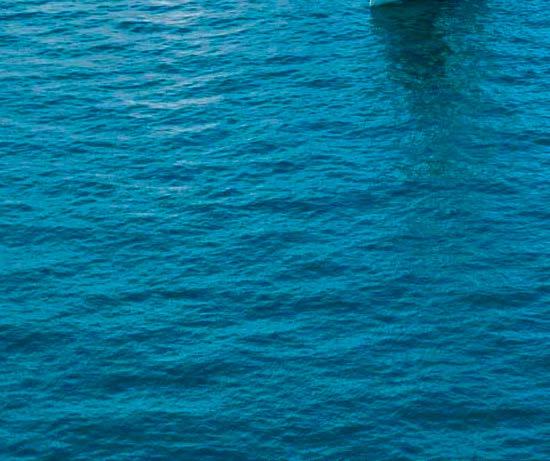
Admiral’s Cup
Royal Ocean Racing Club, UK
July 17-August 1
Internationaux France match race
APCC Voile Sportive, France
July 18-20
Auckland Winter Sprint Series, round 3 Kohimarama Yacht Club
July 19
Great Britain Sail Grand Prix Portsmouth, UK
July 19–20
Burnsco Elliott 5.9 Traveller Series, race 3
Mercury Bay Boating Club
July 26-27
49er, 49erFX, Nacra 17 junior worlds Copenhagen, Denmark
July 30-August 3
Auckland Winter Sprint Series, round 4 Murrays Bay Sailing Club
August 2
Oakcliff International Oakcliff Sailing, USA
August 4-7
SSANZ LEWMAR Triple Series
Race 2
August 9
Thompson Cup Seawanhaka Corinthian Yacht Club, USA
August 9-12

Wingfoil World Cup
Wingfoil World Cup, round 3
Fenerbahce Sports Club, Turkey
August 13-17
Chicago Grand Slam Chicago Yacht Club, USA
August 15-17
Auckland Winter Sprint Series, round 5 Kohimarama Yacht Club
August 16
Germany Sail Grand Prix Sassnitz, Germany
August 16–17
Hamilton Island Race Week
Hamilton Island Yacht Club, Australia
August 16–23
iQFOiL Games, round 4 Silvaplana, Switzerland August 18-24
The Detroit Cup Bayview Yacht Club, USA August 21-24
ILCA under-21 world championships Dún Laoghaire, Ireland
August 22-29
Wingfoil World Cup, round 4 Daishan, China
September 3-7
Auckland Winter Sprint Series, round 6 Wakatere Boating Club
September 6
SSANZ LEWMAR Triple series
Race 3
September 6

Formula Kite world championships
Burnsco Elliott 5.9 Traveller Series, race 4
Opua Cruising Club
September 6-7
iQFOiL under-23 world championships Portimao, Portugal
September 6-13
Formula Kite master’s world championships Goga Beach, Turkey September 10-14
Rockwool International France Sail Grand Prix Saint-Tropez, France
September 12-13
Auckland Winter Sprint Series, round 7 Murrays Bay Sailing Club
September 13
Women’s match racing world championships Chicago Yacht Club, USA
September 17-20
Rolex Switzerland Sail Grand Prix Geneva, Switzerland
September 20–21
Offshore double-handed world championships Isle of Wight, UK
September 22-October 1
Formula Wing world championships Poetto Beach, Italy
September 24-28
Formula Kite world championships Poetto Beach, Italy
September 27-October 5



Click on the logo for the latest exclusive member benefits from Yachting New Zealand’s partners.




















